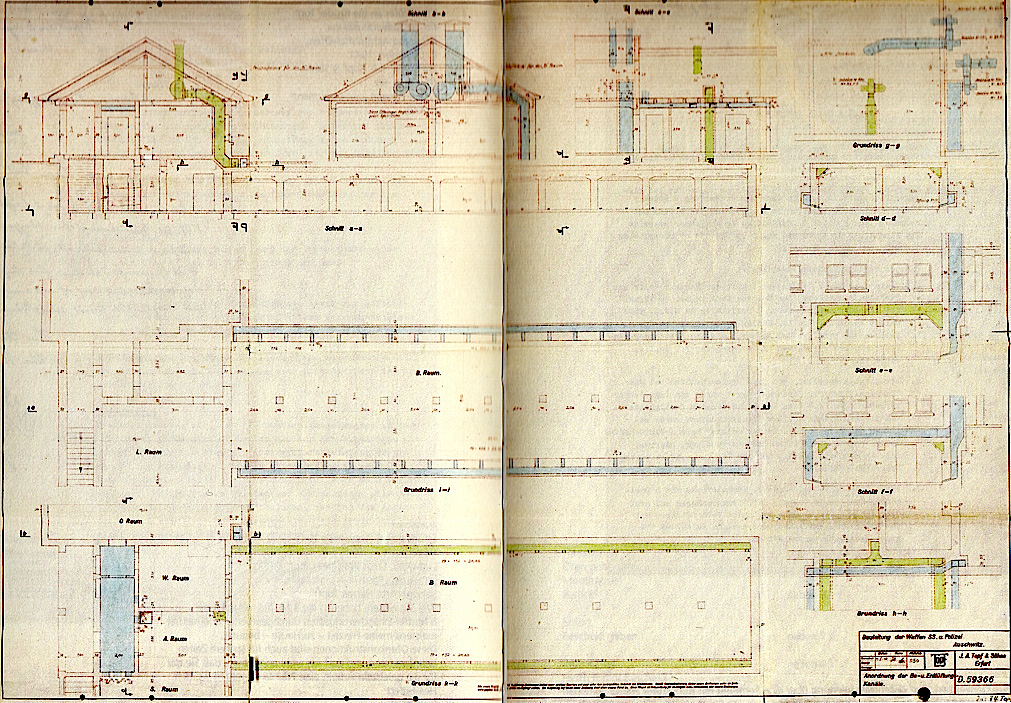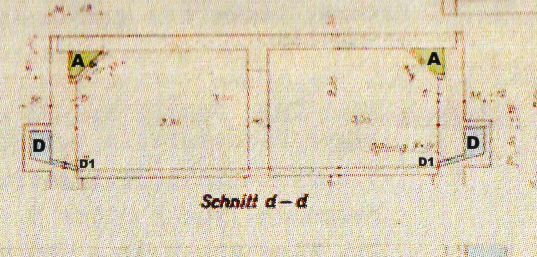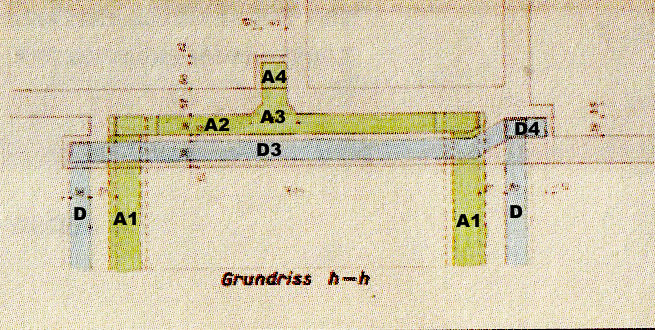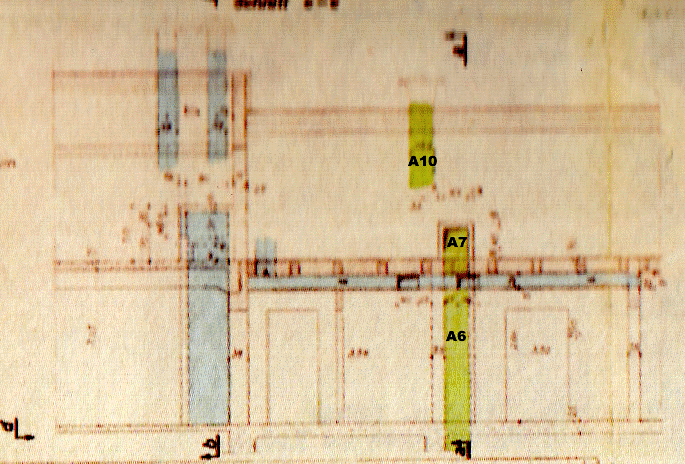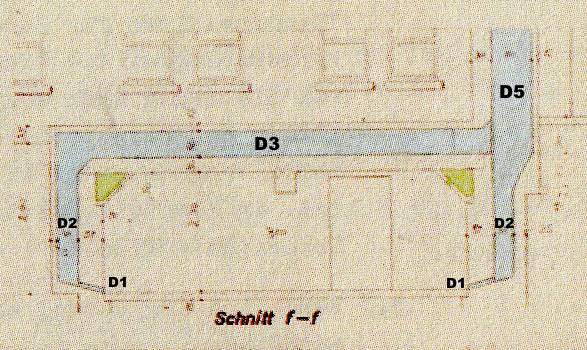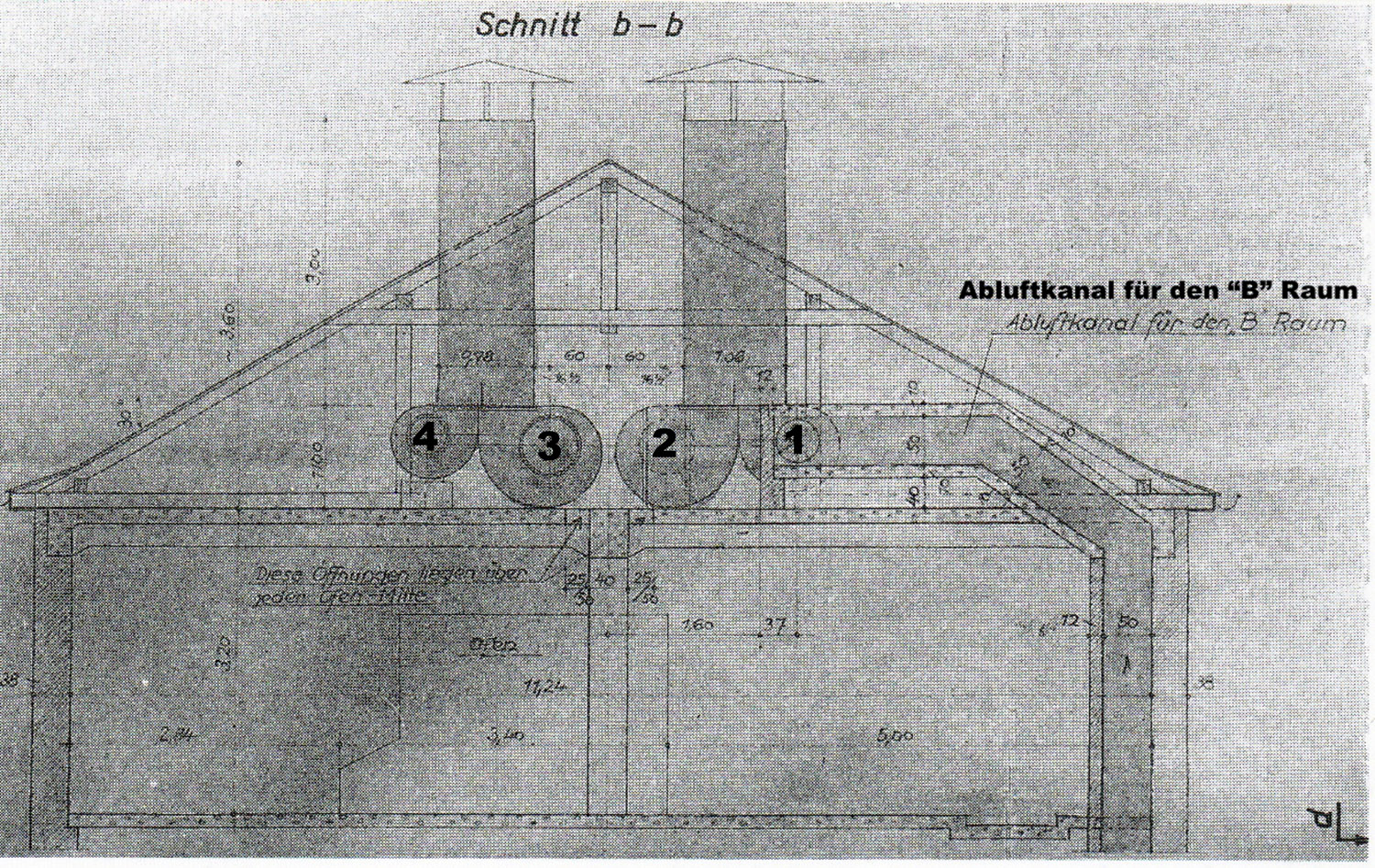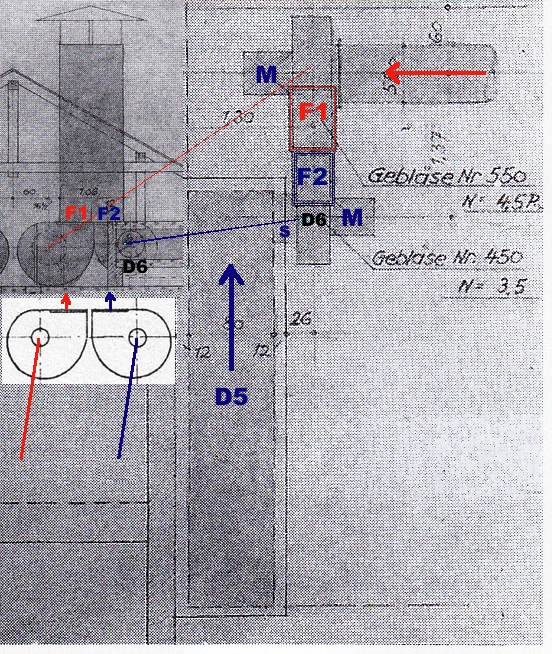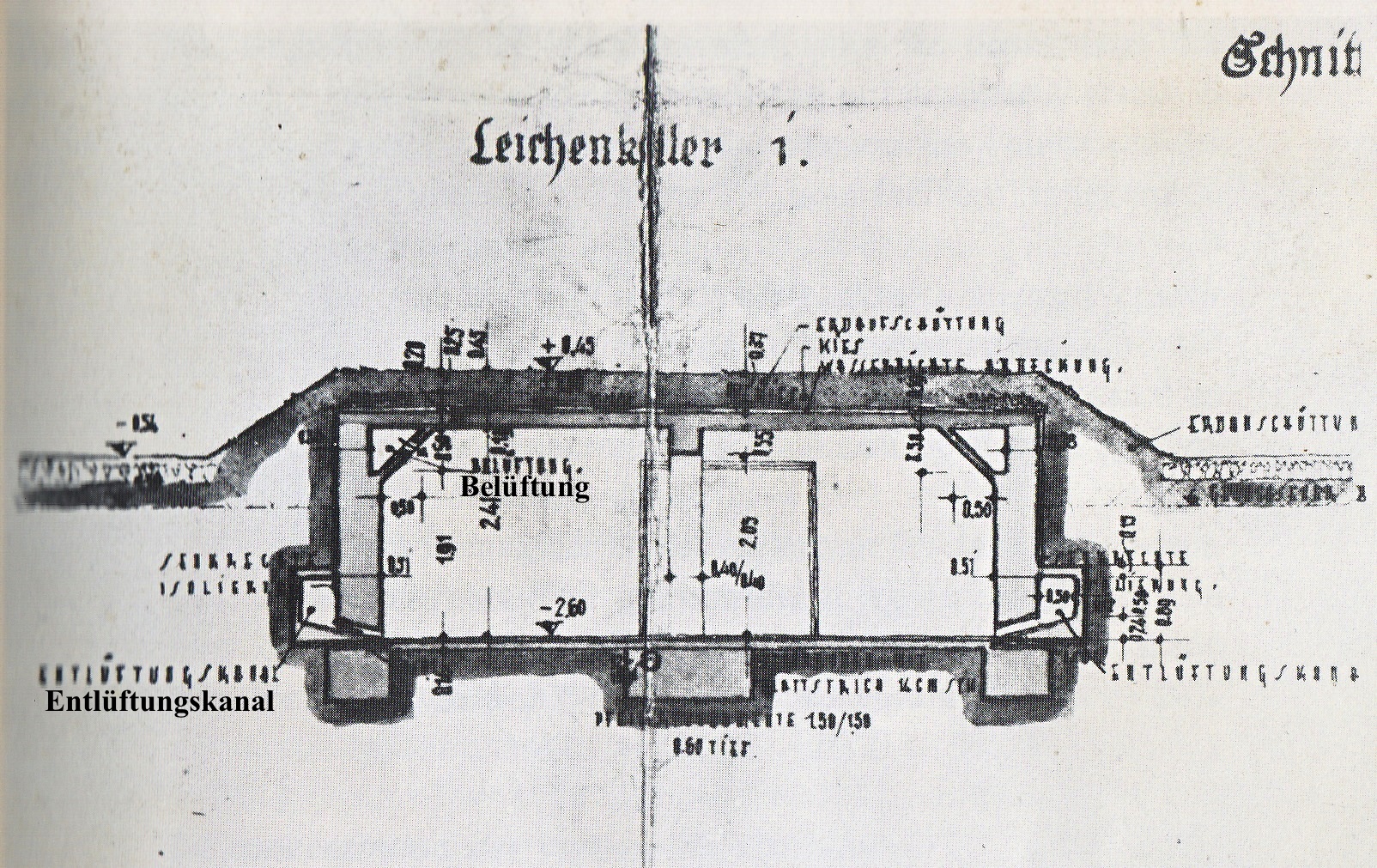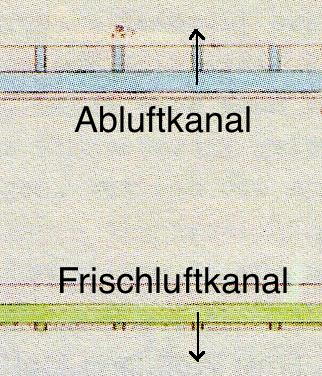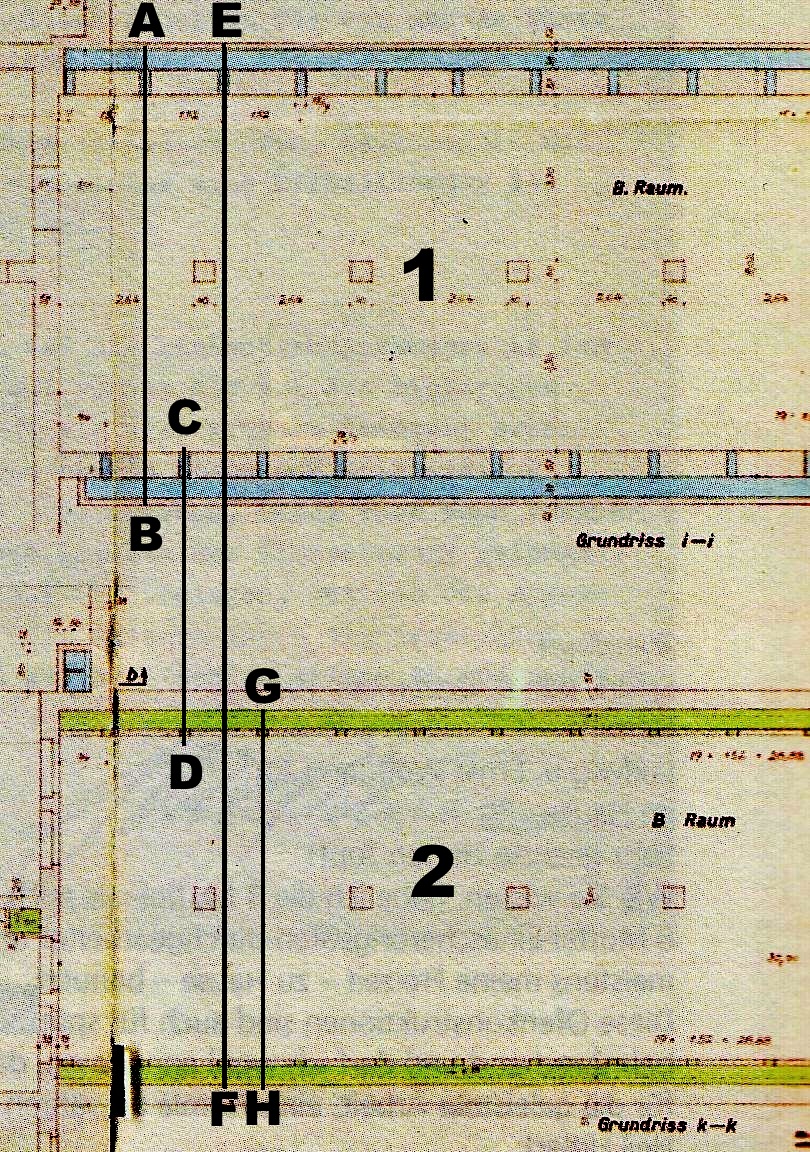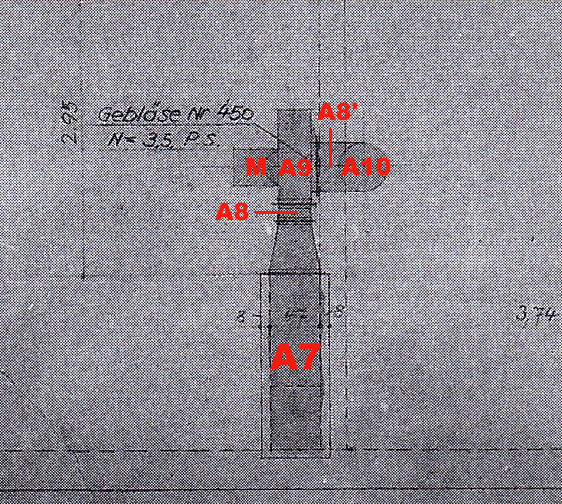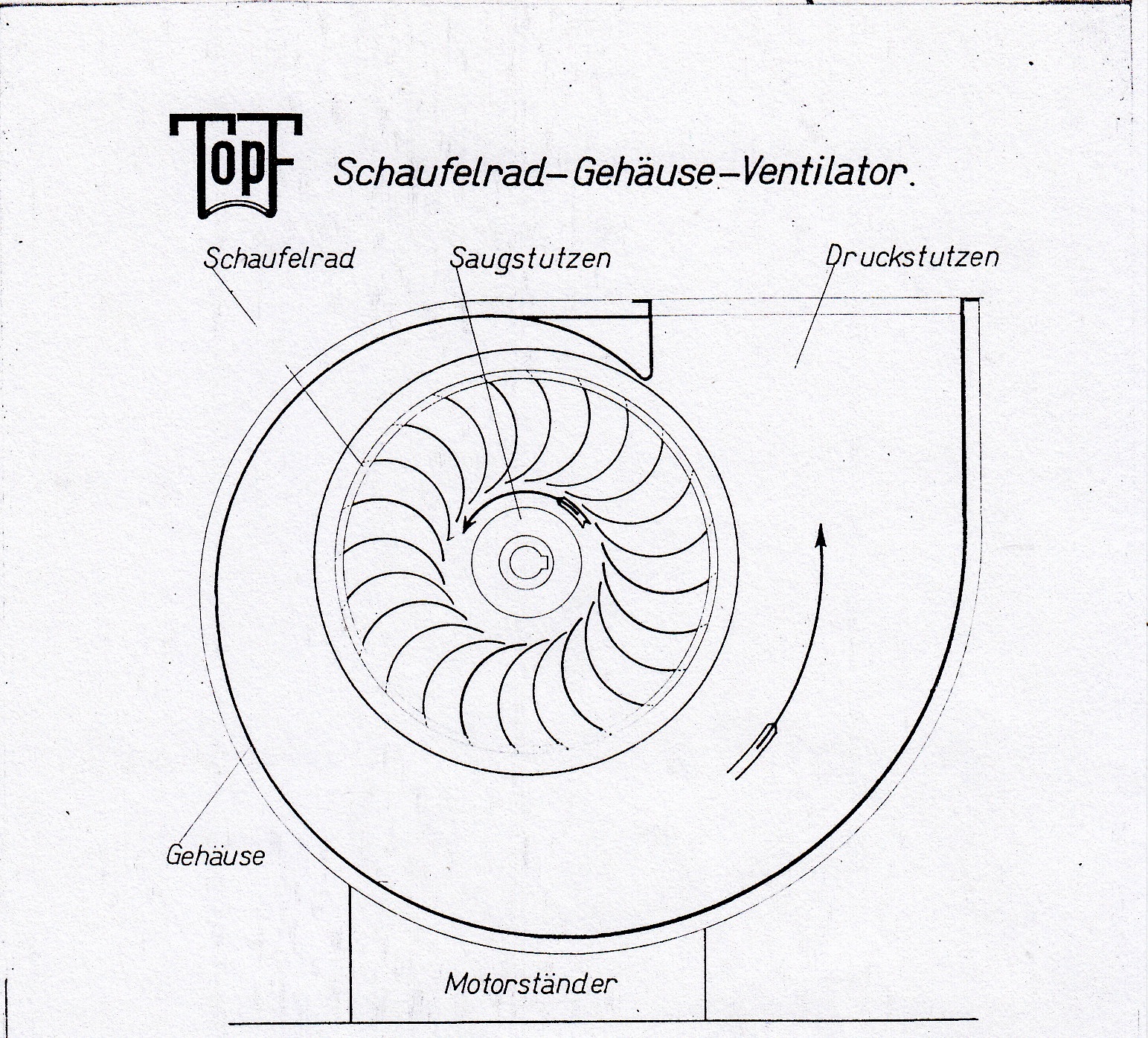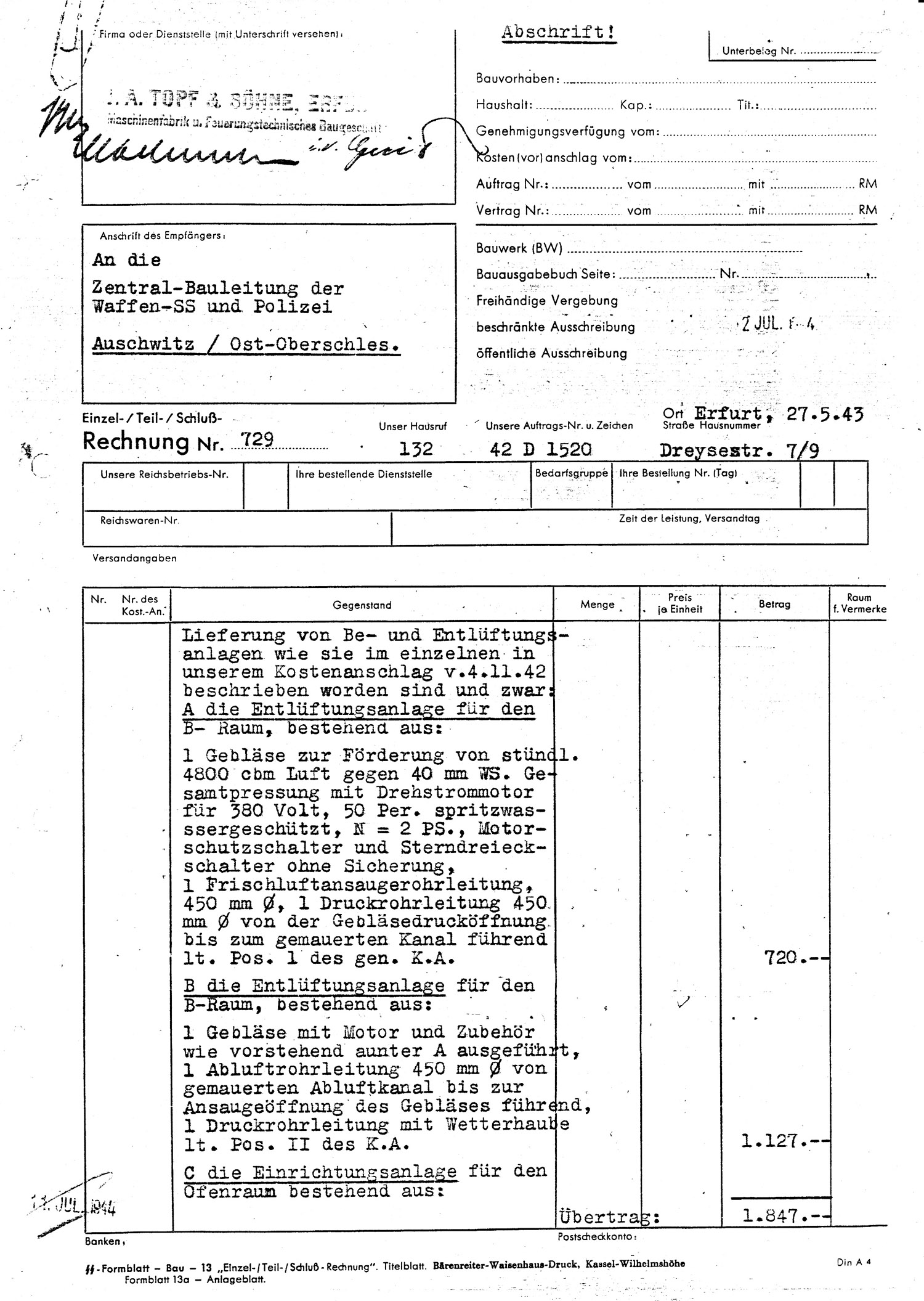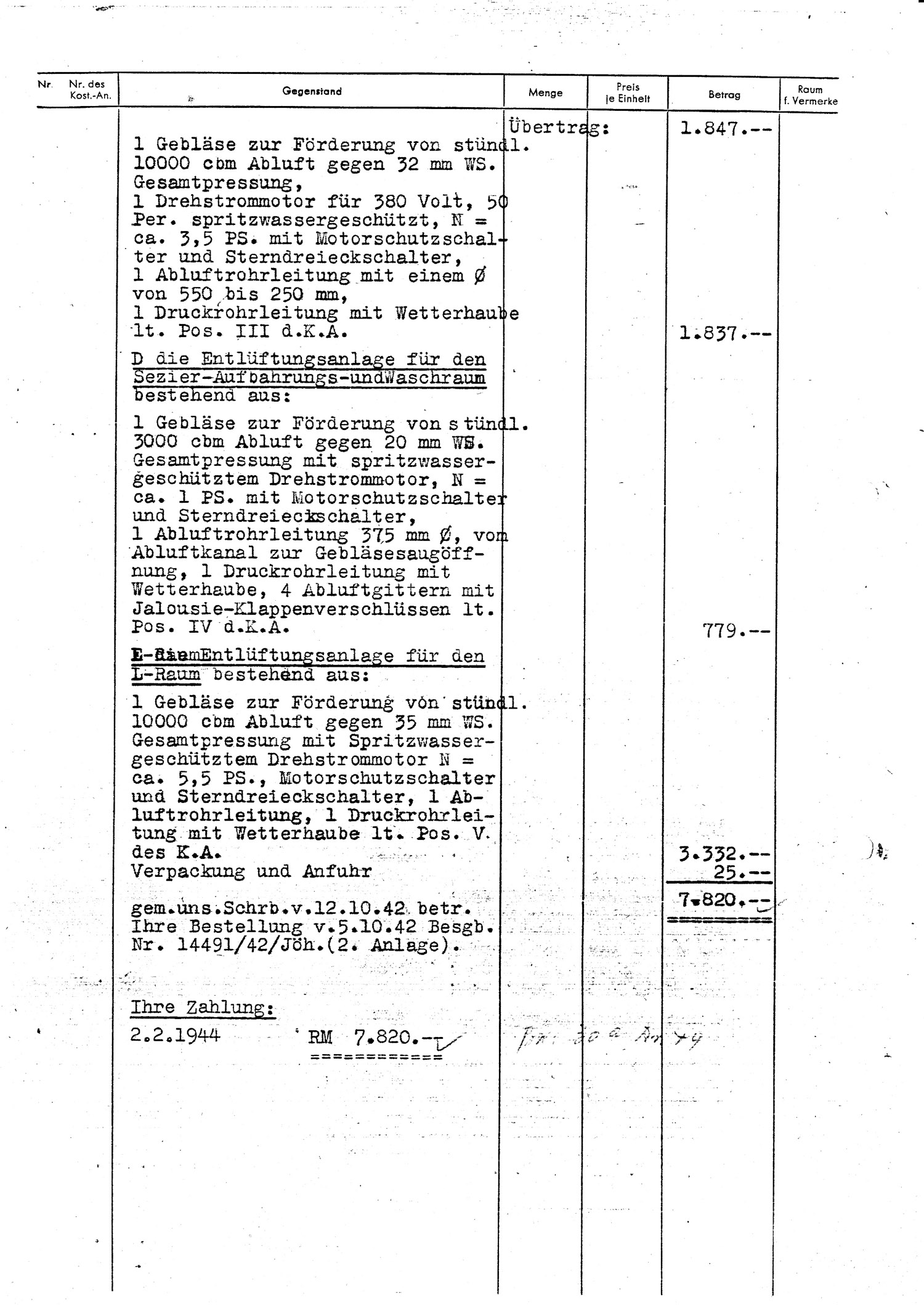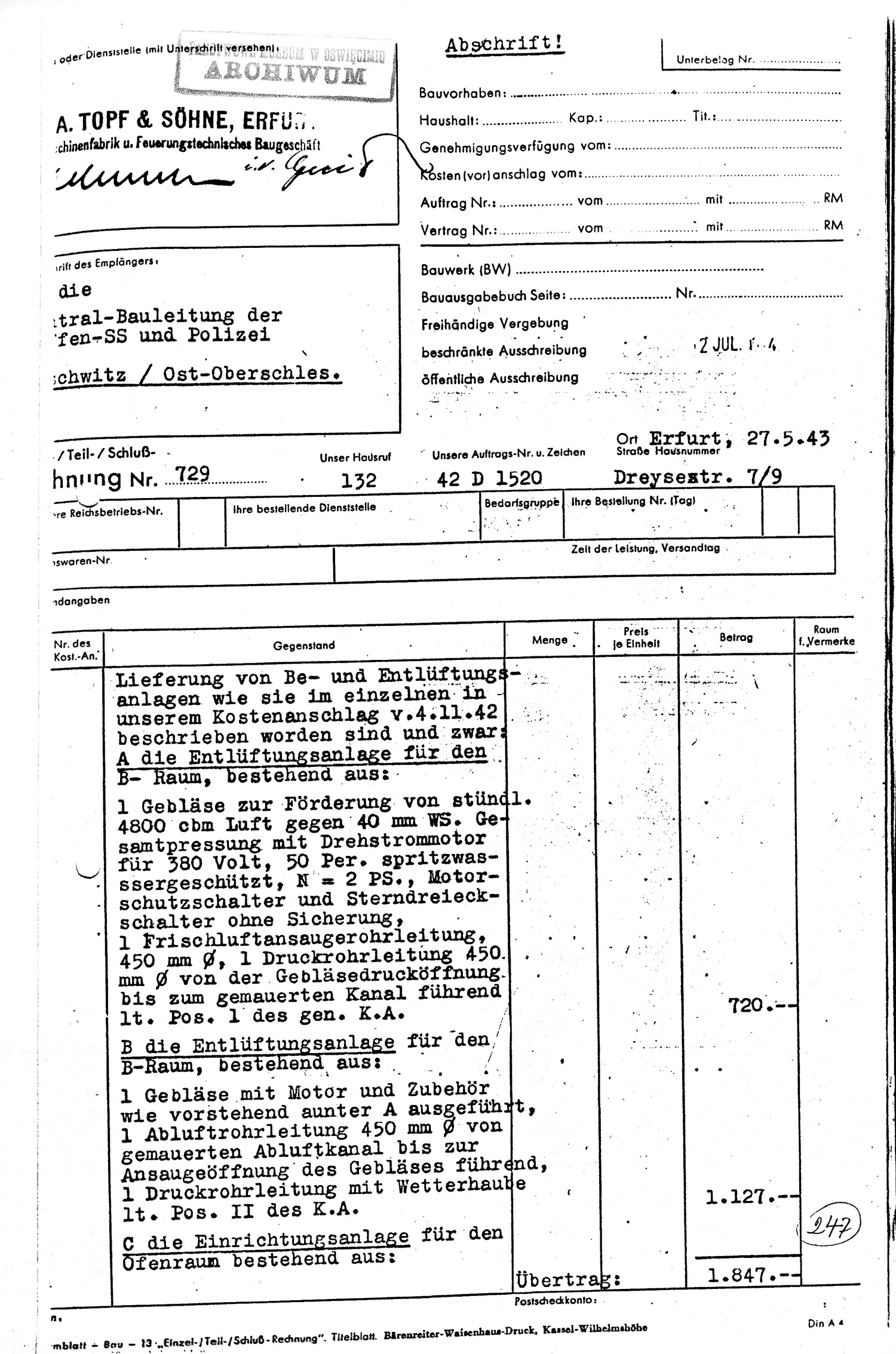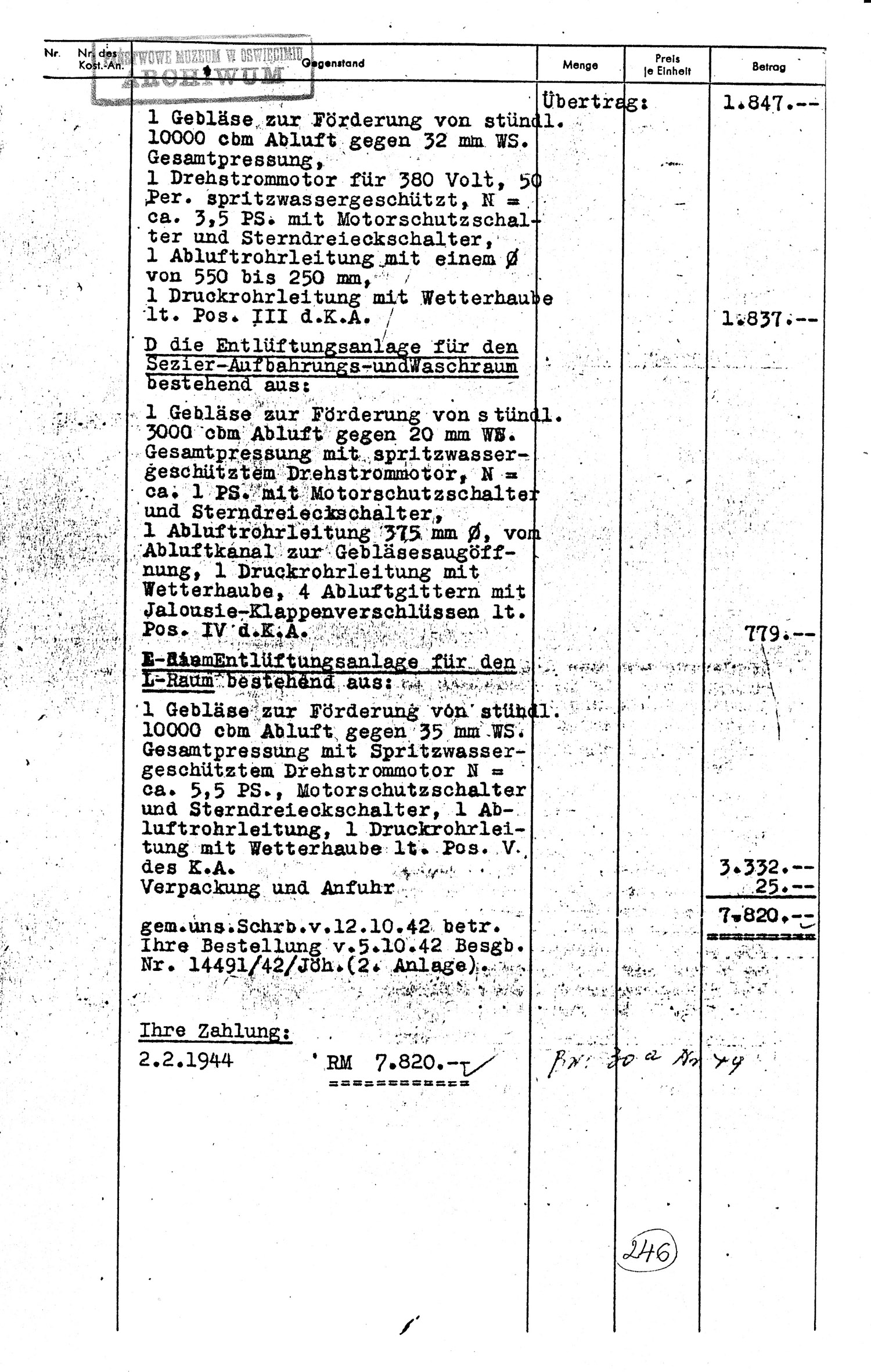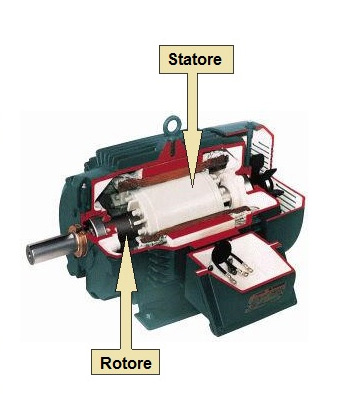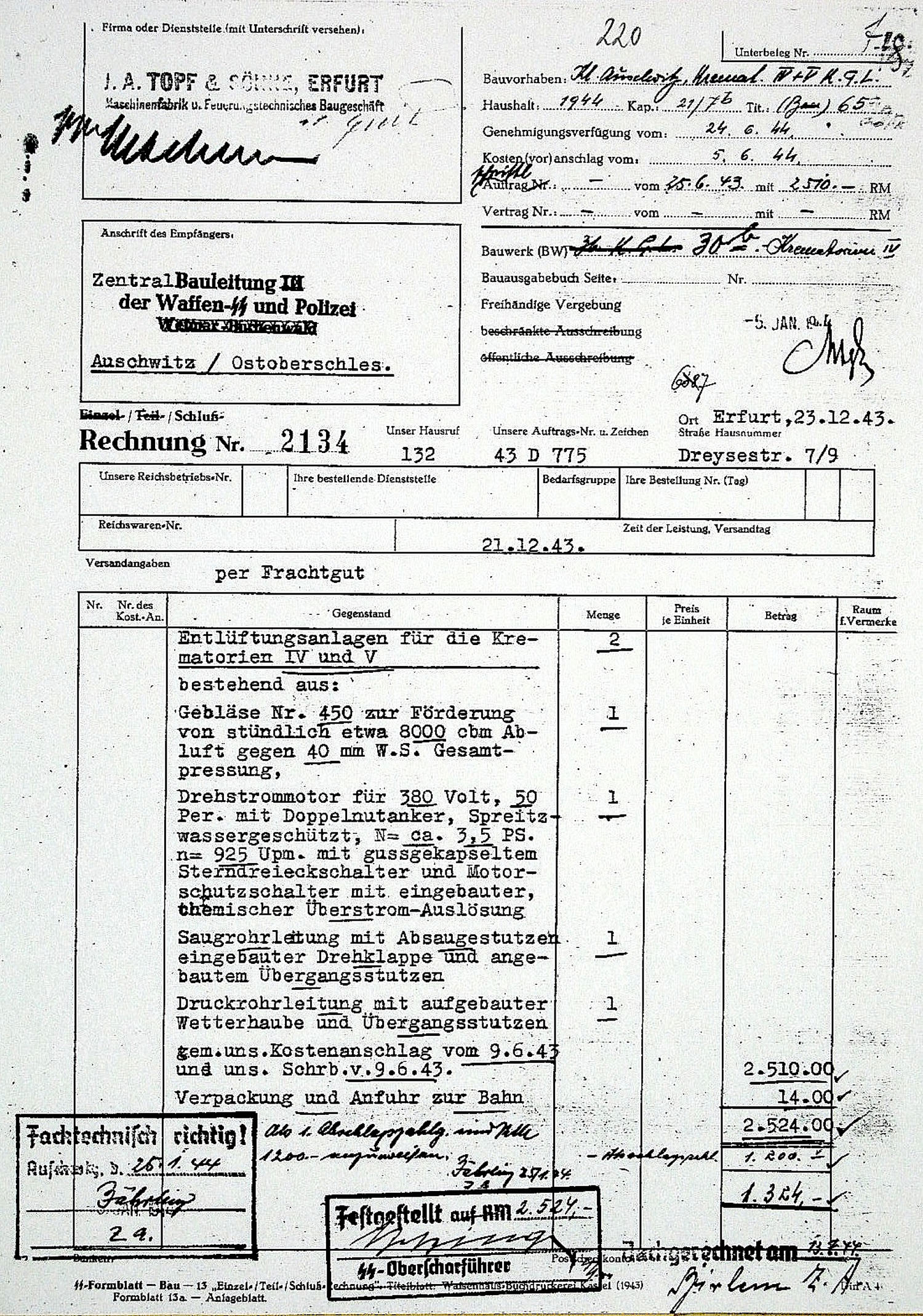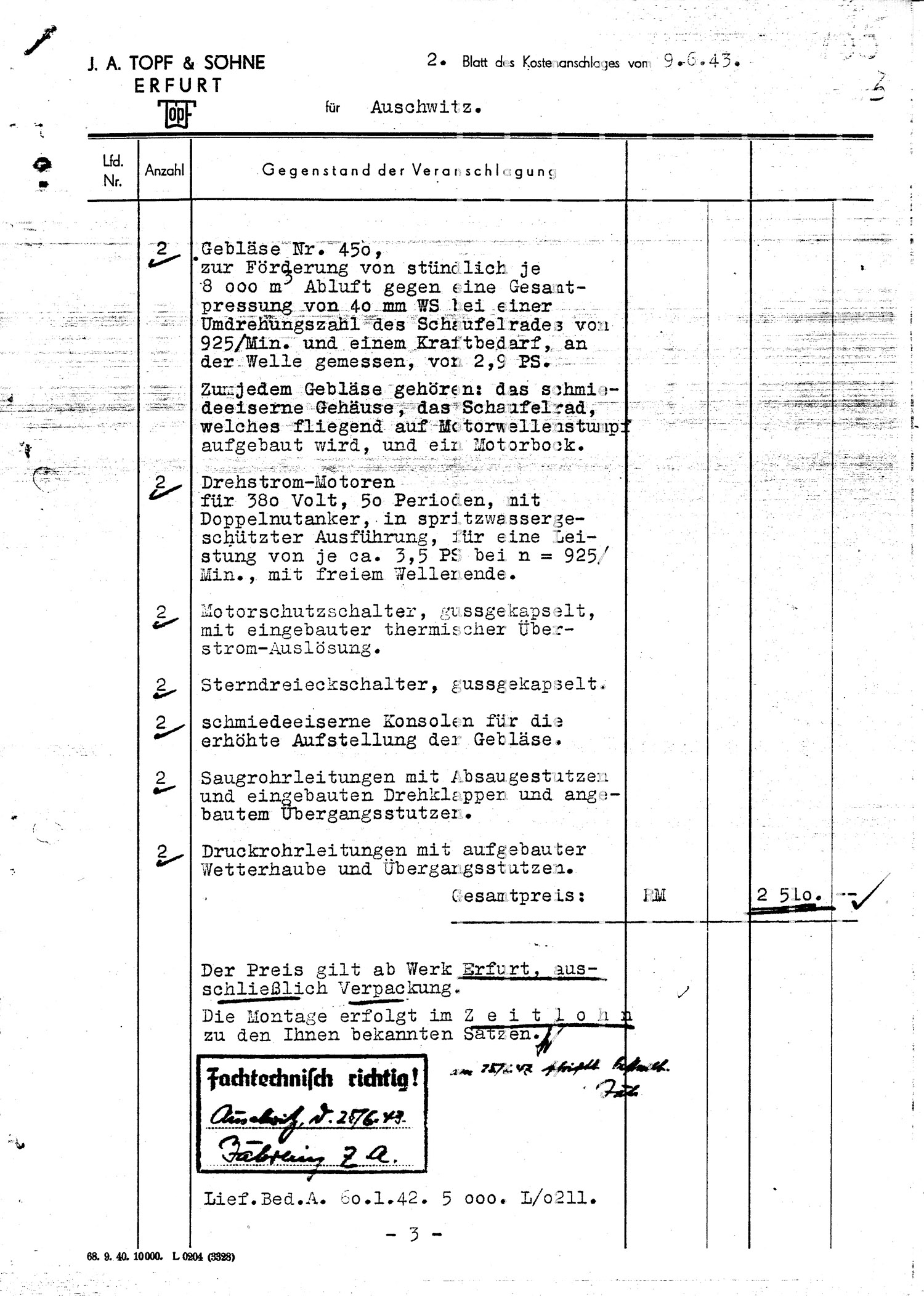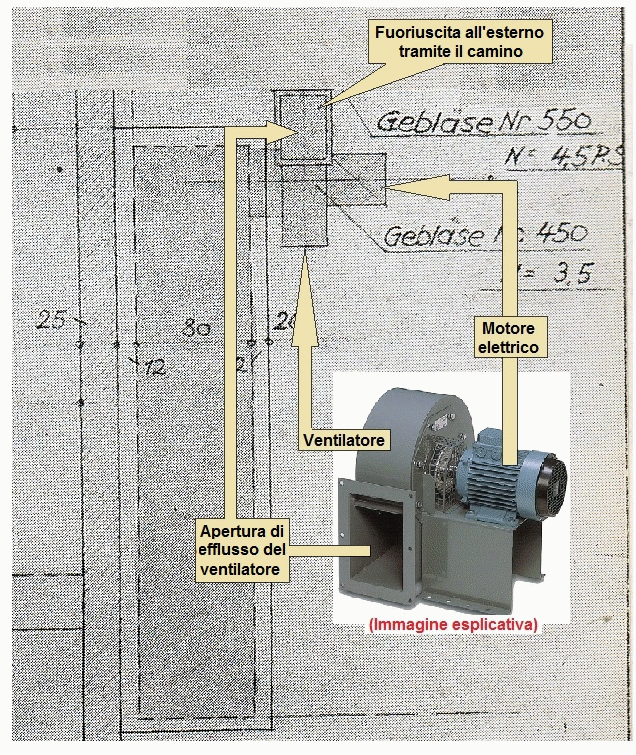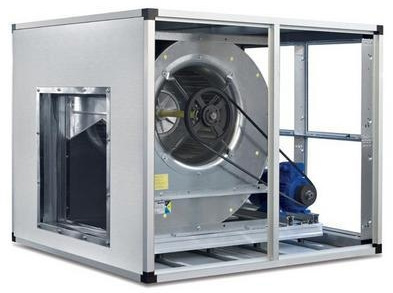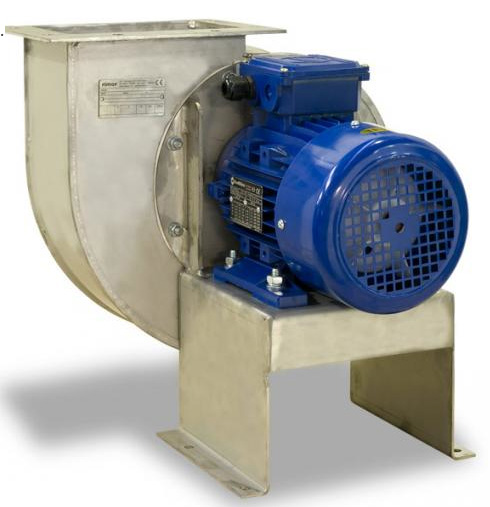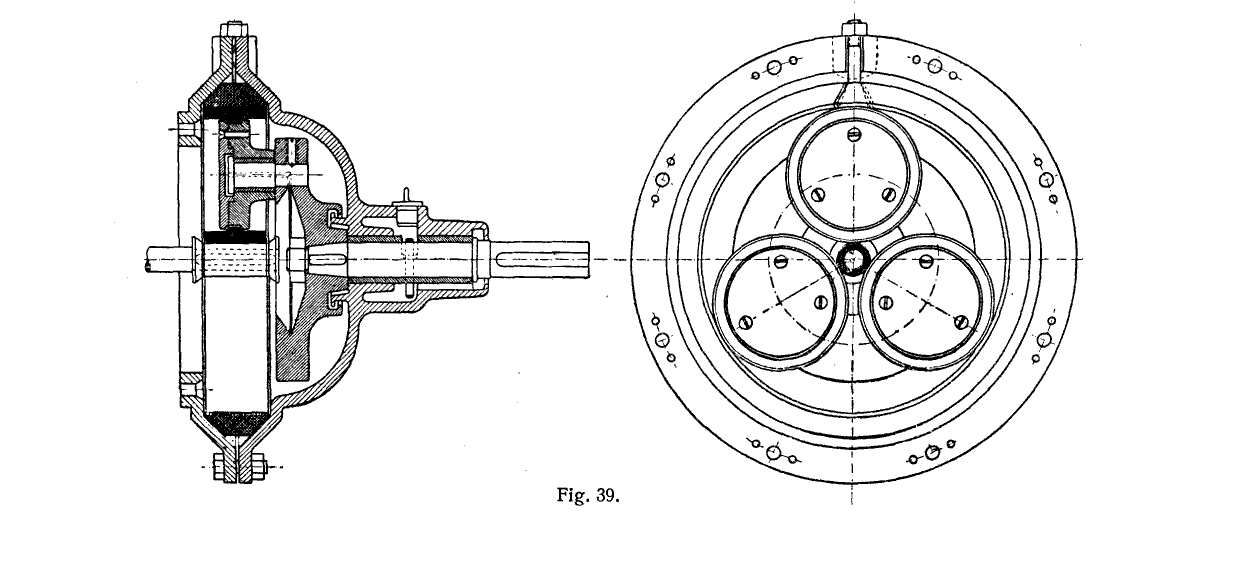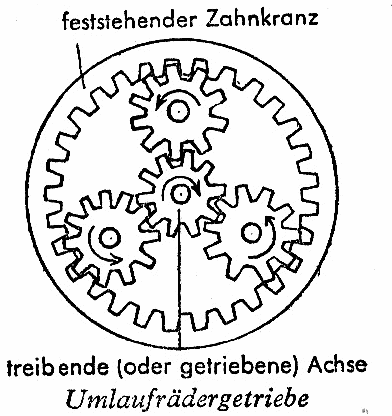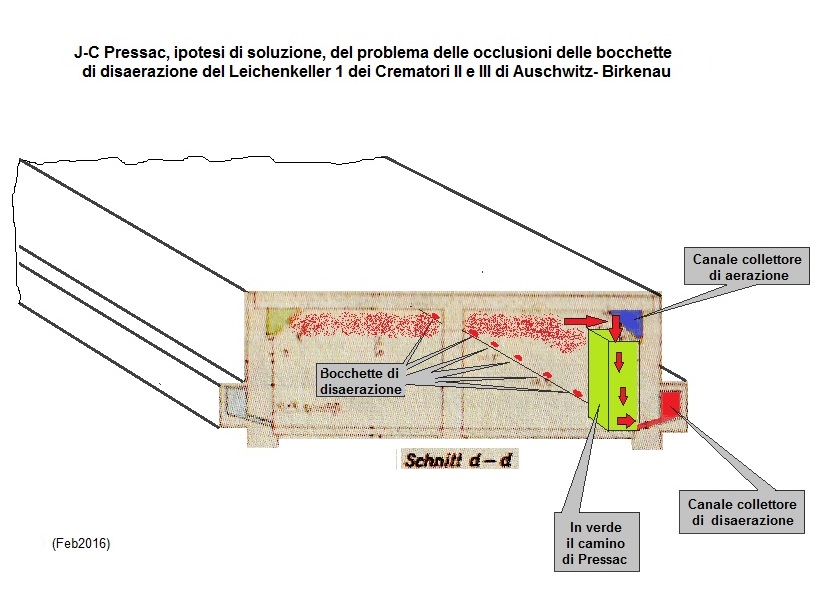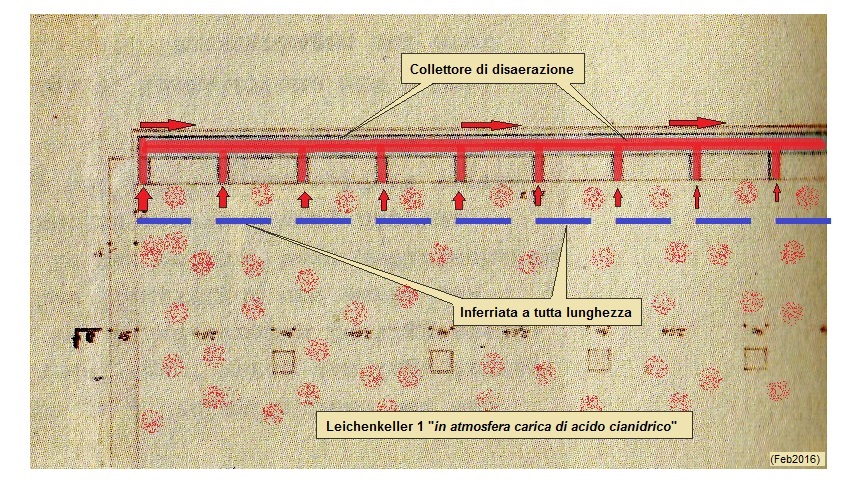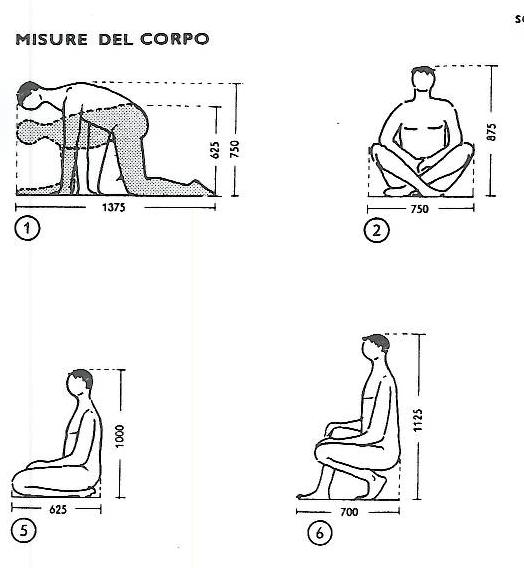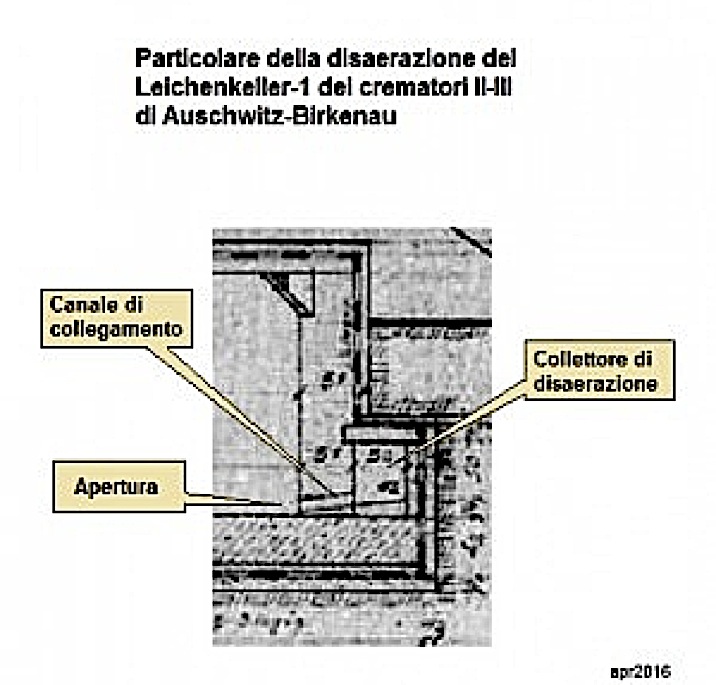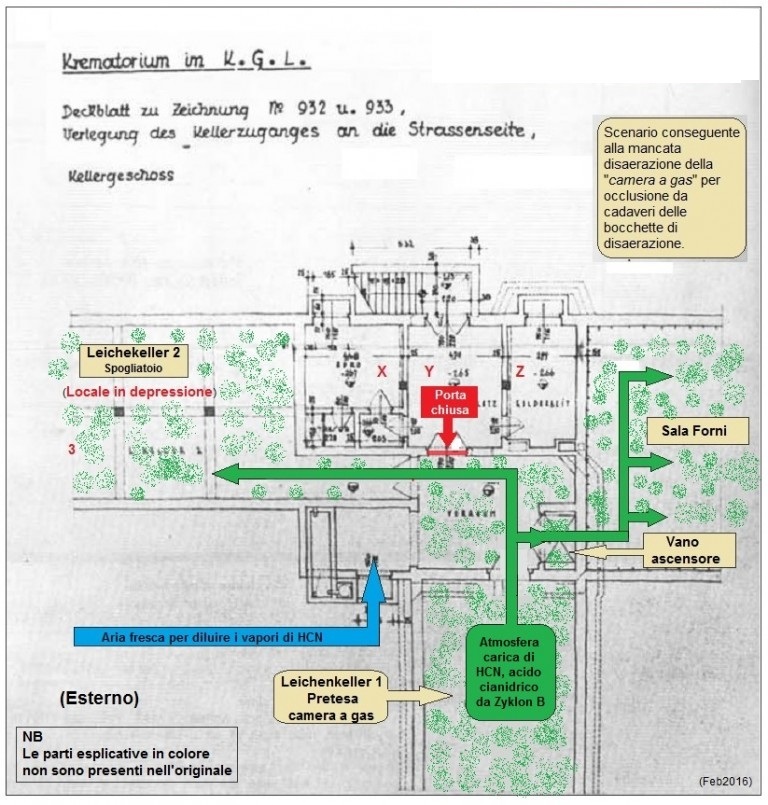The Ventilation Systems of Crematoria II and III in Birkenau
Abstract
Every morgue needs a ventilation system to remove putrid gases developing when corpses decompose. Hence, the basement morgues of the Auschwitz Crematoria II & III had ventilation systems. In 1989, French historian J.-C. Pressac posited that the capacity of these morgues’ ventilation systems was increased in early 1942, and that this change allowed the use of these basement rooms for homicidal purposes. Based on wartime documents and modern expert literature, this paper determines and analyzes the ventilations systems’ features in minute detail, and how it changed during the years 1941-1943. The systems’ features lead to conclusions as to whether these rooms could have been used for homicidal purposes.
Notice
The following study is a revised version of a series of articles written by Carlo Mattogno and Giuseppe Poggi, and published during 2016 on the Italian blog “Olodogma” in a rather polemic context due to contemporary circumstances, whereby the authors adopted the pseudonym “I Carolingi”. The arguments are presented in a logical and structured way, unburdened by any element detracting from a strict documental and technical demonstration.
I) The Ventilation Equipment of the New Crematorium (the Future Crematorium II) of Birkenau
Jean-Claude Pressac claims that Leichenkeller 1 (Corpse Cellar 1 or Morgue #1) of Crematorium II of Birkenau was projected as a normal morgue, and that only at the end of 1942 it was transformed into a homicidal gas chamber. His general arguments have already been discussed in detail elsewhere.[1] In the present study, the function of Morgue #1 is examined from another point of view.
Documents
Click on image
to open large version
Document 1
Document 2
Document 3
Document 4
Document 5
Document 6
Document 7
Document 8
Document 9
Document 9a
Document 10
Document 11
Document 12
Document 13
Document 14
Document 15
Document 16
Document 17
Document 18
Document 19
Document 20
Document 21a
Document 21b
Document 21c
Document 21d
Document 22
Document 23
Document 24
Document 25
Document 26
Document 27
Document 28
Document 29
Document 30
Document 31
Document 32
Document 33
Document 34
Document 34a
Document 35
Document 36
Document 37
Document 38
Document 39
The ventilation system (intake/exhaust) of the new crematorium (the future Crematorium II) of Birkenau was designed by the engineer Karl Schultze of the Topf Company on March 10, 1942. It consists of a plan of the crematorium (D-59366),[2] in vertical and horizontal sectional views, in which the ventilation system of the prospective Morgue #1 – here called “B.Raum” (Belüfteter Raum, ventilated room) is very well highlighted. See Document 1. This ventilation system was composed of an intake pipe for the fresh air supply (Frischluftkanal) of green color, as well as an exhaust pipe for the stale air (Abluftkanal) of blue color.
The map shows the distribution of the intake and exhaust ducts in the various horizontal and vertical sections.
1) Intake
The two longitudinal brickwork ducts are positioned at two edges on top of the room. In Document 2, the vertical section, they are indicated with the letter A. Document 3 represents a horizontal section of the two ducts (A1) which run into a crosswise duct (A2) above the door; it presents the opening (A3) of a short horizontal duct which becomes vertical in A4; A4 is indeed the visible horizontal section of this vertical duct. The crosswise duct A2 and the opening A3 are drawn in Document 4 (vertical section). The position of section A4 of the vertical duct is indicated in Document 5: it rises from the basement up to the attic of the crematorium, running through the A-Raum (Aufbahrungs-Raum, laying-out room for the corpses).
This vertical tract of the duct, which we indicated with A6, is represented in Document 6 (vertical section of the ground floor and of the attic); in the attic, running through a bend, the duct becomes horizontal again, and it ends in opening A7 in front of the air-blower.
Document 7 shows a vertical section of the duct A6 which discharges into the Opening A7; A8 is the connection sleeve between the brickwork duct and the air-blower A9, while A10 is the intake tubing or chimney. At the bottom A2 is the vertical section of the duct A2, A3 is the short duct, which connects the horizontal duct A2 to the vertical one A6, and A4 is the point in which the section A4 appears in Document 3.
On April 2nd, 1942, the head of the Central Construction Office, Karl Bischoff, at the time SS-Hauptsturmführer, notified the Topf Company of the decision to implement the intake and exhaust chimneys, which were originally planned to be made of metal plates “in the form of brickwork chimneys” (in Form gemauerter Kamine).[3] We will return to this issue in § I. 8) (“Later modifications”).
2) Exhaust
Two horizontal ducts D run along the bottom, behind the brickwork of the room, and are connected to this through the openings D1 (Document 2). In accord with the internal wall, the two ducts turn 90 degrees towards the top into two vertical ducts D2; the left duct turns again 90 degrees, and it flows into a horizontal duct D3, which runs above the door, and enters into vertical duct D5, which is the extension of the right duct D2 (Document 8). As one can see in Document 3, duct D3 runs in front of the intake duct A2, and it flows into the vertical duct D5, of which D4 represents the horizontal section. Document 5 shows the dislocation of this opening D4, at the edge of the O-Raum (Ofen-Raum, furnace room). In Document 4, D5 is the vertical section of this vertical duct. As shown in Document 9, it runs through the ground floor, and with a turn, it becomes horizontal again and is connected to the air-blower D6; D7 is the exhaust tubing.
3) Exhaust Chimney
Document 10 shows the view from above and from the front of the exhaust air-blowers of the furnace room (in red), and Morgue #1 (in blue), and the common brickwork chimney.
- Morgue #1: horizontal duct D5 is connected by the sleeve S to the air-blower D6; the stale air exits from the opening of the air-blower F2 and enters the vertical duct of the chimney.
- Furnace room: the hot air exits through the opening of the air-blower F1 and flows into the vertical duct of the common chimney. The motors of the air-blowers are indicated with the letter M.
4) Intake and Exhaust Ducts in Morgue #1
Inside Morgue #1 fresh air entered through 2 triangular-shaped ducts installed behind the masonry of the room, positioned on the two upper angles (Document 2, A).
For the extraction of the stale air, two masonry ducts were installed on the bottom, at a short distance from the floor of the room, behind the longitudinal walls (Document 2, D).
The Construction Office blueprint no. 934 of January 27 1942[4] shows the four ventilation ducts positioned symmetrically at the two sides of the room and configured respectively as “Belüftung” (intake) and “Entlüftungskanal” (exhaust duct). See Document 11.
The slanted part of the two intake ducts directed to the room featured 40 openings, 20 for each side, which allowed the flow of fresh air into Morgue #1. Also, the exhaust duct was connected to the room through 40 openings, 20 for each side, which slanted towards the floor (Document 2, D1), as it is clearly visible in Document 12, which shows a section of these two ducts.
The 40 bottom openings for exhaust were placed behind the brickwork of Morgue #1, 20 on each side, alternating in location. The openings on the left side (having their backs toward the crematorium’s main building) were located at a distance of 152 cm from each other, measured at the center of each opening. The design project of March 10, 1942, also shows the indication “19 x 152 = 2,888”. The number 19 corresponds to the number of spacings between one opening and the next (20 openings = 19 spacings). The sequence of the spacings, starting from the wall towards the crematorium, is as follows: 0.36 + 28.88 + 0.76 = 30 meters, where 0.36 m and 0.76 m are the wall sections before the first opening and after the last opening. The openings on the right side were placed in such a manner that each opening was placed exactly between the two openings on the opposite wall, as Document 13, section 1, segment A-B shows. The same system was also adopted for the intake openings, which were also designed in alternate locations (section 2, segment G-H).
The sections 1 and 2 of Document 13 represent, respectively, the lower and upper part of Morgue #1; the exhaust openings of the bottom right side of the room were located in a position exactly corresponding to the openings of the upper left side of the intake duct (segment C-D), and those exhaust openings of the bottom left side corresponded to those of the upper right side of the intake duct (section E-F). This system guaranteed the best air circulation inside the room and therefore the best air exchange, avoiding the laminar flows with subsequent clusters of stale air.
5) The Throttles of the Ventilation Ducts
These devices are mentioned in a handwritten note of February 3, 1943 by the installer of the Topf Company Heinrich Messing, who writes:[5]
“Frischluftgebläse Nr. 450 für L. Keller I mit Saug- und Druckstutzen Drosselklappe”
“Air blower for fresh air no. 450 for Morgue #1 with aspiration and exhaust sleeve [and] butterfly valve.”
The Druckstutzen (exhaust sleeve; Document 14) was the connection (A8) which linked the air-blower (A9) to the brickwork duct towards Morgue #1 (A7), the Saugstutzen (aspiration sleeve) was the connection (A8′) which linked the air-blower (A9) to the aspiration duct (A10), here represented in horizontal section (in fact it was the intake chimney for fresh air). M represents the motor of the air-blower.
This is confirmed by a drawing of the air blowers of the Topf Company (Document 15),[6] which clearly indicates Saugstutzen (aspiration sleeve) and Druckstutzen (exhaust sleeve); from the drawing, it results that the aspiration sleeve was linked laterally to the air-blower; the motor was located on the other side.
The Drosselklappe (butterfly valve) of the intake system was installed in the pressure sleeve (after the air blower); in the exhaust system, the butterfly valve was installed in the aspiration sleeve (before the air blower). Since the intake and exhaust ducts were structurally different, also different were their capacity losses; the aforementioned valves were needed to keep the whole ventilation system in balance.
6) The Grates of the Ventilation Openings in Morgue #1 (Crematoria II and III)
The “protocol” issued by the Polish investigating judge Jan Sehn on July 24, 1945, which was later presented at the Höss trial,[7] recaps all the internal orders related to the crematoria in Birkenau made by various Auschwitz offices to the inmates’ metalworking shop (Häftlings–Schlosserei). The internal orders are summarized with the transcription of the German text (the original documents were mostly handwritten), mingled with Polish terms.
As far as the closing devices of the ventilation openings of Morgue #1 are concerned, made in the form of grates, the “protocol” reports the following registrations:
– Crematorium II:[8]
“18.2.43, Nr. 83. K.G.L. Krematorium II.BW.30. Przedmiot [concerns] … 50 Stïck [sic, for: Stück] Blechsiebe [50 pieces sheet-metal screens] 7 x 18 cm. Liefertermin [delivery date] 17.2.43”.
“19.2.43. Nr. 103. Krematorium BW 30. Przedmiot: Schutzgitter vor die Abluftlöcher aus 10 mm ø Eisen lt. beigefügter Skizze. Auftrag Nr. 2575 vom 3.2.43 der Zentralbaultg. Von der ehem. Häflt. Schlosserei übernommener Auftrag. Ukończono: 15.3.43 [concerns: protection grates in front of the stale-air openings made of 10 mm ø iron according to the enclosed drawing. Order no. 2575 of Feb. 3, 43 of the Central Construction Office. Order accepted by the former inmates’ metalworking shop. Completed: March 15, 43.]”
– Crematorium III:[9]
“15.3.43. Nr. 192. Zentr. Baultg. K.G.L. Krematorium III-Bw.30 a. Przedmiot: … 5/ 45 Stück Schutzgitter für die Abluftlöcher aus Rundeisen ø 10 mm. 6/ 95 Stück Zinkblechsiebe 7 x 18 cm/: f. Keller 1: /. Lieferzeit: Dringend Baults. Auftrag Nr. 83 bom [vom] 14.3.43. Wykonawcy: Dyntar, Puzyger, Durski, Kostkowski. Ukończono: 22.3.43 [concerns: … 5/ 45 items protection grates for the stale-air openings made of round iron bars ø 10 mm. 6/ 95 pieces of zinc-coated sheet-metal screens 7 x 18 cm/: for basement 1: /. delivery date: urgent. Order of the Construction Office no. 83 of March 14, 43. Made by: Dyntar, Puzyger, Durski, Kostkowki. Completed: March 22, 43.]”
To recap:
- Crematorium II; fresh-air intake: 50 sheet-metal screens
Crematorium II: stale-air exhaust: ? iron-rod grates. - Crematorium III: fresh-air intake: 95 sheet-metal screens
Crematorium III: stale-air exhaust: 45 iron-rod grates.
From these internal orders, Pressac deduced that the project of March 10, 1942 was modified for what would concern the openings of the ventilation ducts of the future Morgue #1; those of the fresh air were not 40 anymore, but 50, at a distance of 1.20 m from each other, resulting in the following calculation: (30 + 30) ÷ 50 = 1.2 (double the length of the room in meters, divided by the number of protection devices).
In Crematorium III, according to Pressac, 95 openings were made (evidently 47 on one side and 48 on the opposite wall), one every 60 centimeters, in the fresh-air duct and 45 openings (22 on one side and 23 on the opposite wall), one every 1.5 meters, in the stale-air duct.[10]
With this system, the fresh air entering from two intake openings had to be extracted from a single exhaust opening, thus creating a net imbalance in the intake-exhaust system of the original project. Pressac does not explain this obvious anomaly: why 50 intake openings were necessary in Crematorium II, but 95 in Crematorium III.
The main problem is that nothing is known about these architectural alterations. The only reference to them, which is not mentioned by Pressac, and which is rather enigmatic, appears in a letter of the Topf Company to the Central Construction Office of May 8, 1942, which has as a reference, “Intake and exhaust system for the crematorium to be built in the KL Auschwitz” (Be- und Entlüftungsanlage für das zu errichtende Krematorium im K.L. Auschwitz):[11]
“Die Raum-Abmessungen der Leichenkeller 1 und 2 haben sich geändert. Hieraus ergeben sich für die Frischluft Zu- und für Abluft-Rückführung andere Eintritts- bezw. Austrittsöffnungen.”
[“The room measurements of Morgue #1 and 2 have changed. Therefore, other entry and exit openings for the intake of fresh air and for the exhaust of stale air result”.]
In fact, the dimensions of Morgue #1, 30 x 7 x 2.40 m, remained unchanged. The above-mentioned letter and the one of May 21, 1942,[12] which will be discussed later, make specific reference to two plans of the Topf Company, D 59394 and D 59395, a floor plan and a vertical section of the new ventilation system. Apparently, these documents have been lost; therefore it is not known which modifications were proposed by the Topf Company, or if they were eventually accepted by the Central Construction Office. No plan of Crematoria II and III and in fact no document dated later than May 21, 1942 contains any mention of these modifications, therefore the openings connecting the intake and exhaust ducts of Morgue #1 were constructed according to the plan of March 10, 1942.
Any modification after the construction of the crematorium appears rather improbable, if not illogical.
The explanation of Pressac – that on each side of Morgue #1, 25 openings were placed at a distance of 1.20 m from each other – would have been a radical and total change of the system envisaged in the plan design of March 10, 1942. In fact, if the first opening of this plan had been left unchanged, none of the remaining 19 openings would have been coincidental with the 24 of the new project, or in other words, no overlap of old and new openings would have occurred, because the new ones had a different “pitch” (distance) from each other. Therefore, it would have been necessary to drill 48 new holes in the 51-cm-thick brick wall in order to create the new openings.
And besides, during the week preceding the day of the first order for the manufacturing of the protection grates (February 18, 1943), the Topf Company sent the Auschwitz Central Construction Office various letters which also mentioned the ventilation of the crematoria, in particular the days of 11, 12 and 17 (see below, § II). On March 17, Bischoff, meanwhile promoted to SS-Sturmbannführer, notified the shops of the Deutsche Ausrüstungswerke that, in the basement of Crematorium II, the dimensions of a door had to be changed “für eine bauliche Abänderung” (for a structural modification).[13] A few days later, on the 26th, the plan to create an access to Morgue #2 (Eingang Keller 2) of Crematorium II was established.[14] It is therefore not credible that a structural modification of the openings connecting the intake and exhaust of Morgue #1 would have been implemented without any documentary trace. Such a change would moreover have been completely illogical: the motivation mentioned in the Topf letter of May 8, 1942 was in fact unsubstantiated, because Morgue #1 did not incur any volumetric change.
The installer of the Topf Company, Heinrich Messing, worked on the ventilation system of Morgue #1 of Crematorium II in the week from March 8, to March 14, 1943. He performed functional tests, and on March 13 he activated the system (“Be- und Entlüftungsanlagen Keller I in Betrieb genommen”, “Intake and exhaust ventilation systems in the basement I activated.”)[15]
At the time the internal orders for the protection devices (grates) had already been placed, but who, if not Messing, would have noticed a possible error in the number of the connecting openings between the ducts and the room; a mistake as substantial as to require such radical modifications? The ventilation ducts in Morgue #1, as explained above, were masonry work, and the change of the number of openings would have required a substantial masonry job.
On the other hand, Messing did not mention any functional anomalies of the ventilation system: if, therefore, the real 40 intake openings or the assumed 50 adequately fulfilled their function, why then would 95 have been necessary in Crematorium III?
Therefore, it must be assumed that the openings remained unchanged, 40 + 40, according to the project of March 10, 1942, and that the discrepant numbers of the protection devices which were ordered from the inmates’s metalworking shop are either the result of transcription errors, or that the devices were ordered in excess, for unknown reasons.
Pressac published some pictures of the protection grates for the openings for fresh air. They were as they appear in Document 16.[16] They were made of a perforated iron sheet welded to a sort of casing which was inserted in the masonry opening. The dimensions appear to conform to the measurements (7 cm x 18 cm) mentioned in the relative orders to the inmates’ fitter’s shop (no. 83 of February 18, 43 and no. 192 of March 15, 43).
The devices made of round iron bars which protected the exhaust openings for the stale air were without doubt more or less similar to Pressac’s drawing (Document 17).[17]
This seems to be confirmed by a picture taken on August 18, 1968 during excavation work in Morgue #1.17
It must be observed that the protection devices mentioned above were designed for a normal morgue; this is deduced from the fact that, while the stale-air openings had only a grate made of round iron bars, the fresh-air openings were covered by iron sheeting perforated by some 120 holes of 3 mm diameter each. These screens had a rather high air-flow resistance, resulting in the pressure loss along the entire length of the air-intake duct being small compared to the loss at each of those openings. That in turn made sure that the amount of air coming out of each opening was similar, and that the entire room had a reduced pressure compared to the outside.
The air-shutters of the ventilation system (Saugstutzen and Druckstutzen), which without doubt were regulated by Messing during the final inspection, obviously had to remain in an open position.
7) The Function of Morgue #1
The plans of the basement morgue (Leichenkeller) of the Sachsenhausen concentration camp help us understand the project of the morgue of the new crematorium in Birkenau. Even though the documentation in question always refers to “Leichenkeller”, in the singular,[18] the facility contained de facto three morgues, as shown in the attached plan:
- one for corpses without a casket (ungesargte Leichen): 80 corpses in 133.63 m2
- one for the corpses inside a casket (eingesargte Leichen): 100 corpses in 80.63 m2
- one for infected corpses (Infektionsleichen): 20 corpses in 37.51 m2.
The surface areas are calculated net of the area of the concrete supporting pillars.[19]
The first case was similar to the one in Birkenau; the effective surface area of Morgue #1, without the area occupied by the 7 concrete pillars, was – as we will show below – of 208.88 m2; and applying the same coefficient as in Sachsenhausen, it was planned for approximately 120 corpses. It can be assumed that it was planned to place them on the floor; 60 on each side, leaving the necessary space in the center for a transport trolley. Each exhaust opening would have expelled the fetor of 3 corpses. Since the corpses had to be aligned on the floor, the exhaust openings were designed to be at floor level.
The intake from above and the exhaust from below was the only way to assure the continuous apportionment of fresh air, and to assure that the stench created by the initial decomposition of the corpses would be immediately aspirated away, and to pollute as little as possible the air inside the morgue and to inconvenience as little as possible the personnel who had to work there. All this was perfectly normal for a morgue.
8) Later Modifications
The brickwork chimneys of the ventilation system, one isolated and four in a single masonry structure, are drawn in particular on Plan 1311 of May 14, 1942, 2003 of December 19, 1942 and 109/16A (Huta Company) of October 9, 1943.[20] Plan 109/15 of September 24, 1943, also of the Huta Company, shows that the right exhaust duct proceeded over the point D4 of Document 3 up to a vertical exhaust ventilation duct (Entlüftungsschacht) located at the corner of the room labelled “Goldarbeit” (gold work) between the corridor and the furnace room, and which emerged in the first chimney on the right from the group of four mentioned above.
The left intake duct A1, taking into consideration the drawings, also proceeded along the left wall of the vestibule (Vorraum) and emerged in the isolated chimney, which was on the same line, but some meters away. The route of the ventilation ducts for the other rooms is not indicated in the drawings; it is sure that the isolated chimney was employed for the intake of fresh air into Morgue #1 and the group of four chimneys for the evacuation or exhaust of all rooms.
However, there is no agreement with Pressac when he states that the first chimney on the right was planned for the expulsion of the hot air from the furnace room,[21] because the above-mentioned drawings connect it directly to the exhaust of Morgue #1.
And besides, the comparison with the drawing of March 10, 1942 shows that the isolated chimney corresponded to the fresh air intake duct of Document 7 and that the group of the four chimneys represented the bundling into one single brickwork structure of the two sheet-metal chimneys of Document 9, which respectively collected the flux of stale air from two rooms and aspirated by two air-blowers, specified as follows (Document 9a):[22]
- ventilation of Morgue #1 (air-blower Type 450)
- ventilation of the furnace room (air-blower Type 550 with 4.5 HP motor)
- ventilation of Morgue #2 (air-blower Type 550 with 7.5 HP motor)
- ventilation of the dissecting room [Sezierraum], of the laying-out room for the corpses [Aufbahrungsraum] and room for the washing of the corpses [Waschraum] (air-blower Type 375).
In the final project each of these ventilation ducts had its own brickwork chimney.
The data relative to the number and to the power output of the air-blowers is explained in the next section.
II) Capacity of the Air-Blowers of Morgue #1: The Documents
1) The first cost estimate of the ventilation system of the future Crematorium II was prepared by engineer Schultze on November 4, 1941, in which the devices foreseen for the single rooms of the new crematorium (the future Crematorium II) are described. Point I refers to a “ventilation device for room “B”“ (Entlüftungs-Anlage für “B”-Raum) – that is the future Morgue #1. A “tubing for intake of fresh air” (Frischluft-Ansaugrohrleitung) is mentioned, therefore, it is certain that the intake system was implied. In Point II the wording “ventilation device for the room ‘B’” (Entlüftungs-Anlage für “B”-Raum) is repeated, but this time it refers to a “tubing for the stale air” (Abluft-Rohrleitung), and therefore, here the exhaust system was implied.
The technical description of both systems is identical (Documents 18 and 19):
“Gebläse zur Förderung von stündlich 4800 m³ Luft[[23]] gegen eine Gesamtpressung von 40 mm WS bei einer Umdrehungszahl des Schaufelrades von n = 925 min. und einem Kraftbedarf, an der Welle gemessen, von 1,6 PS.”
“Air-blower with the capacity of 4800 m3 of air per hour against a total pressure of 40 mm of water column with a number of revolutions of the blower wheel of n=925 per minute and a power demand, measured at the drive shaft, of 1.6 HP”
Both systems were powered by a 380 volt three-phase motor (Drehstrommotor), 50 cycles (Perioden: Hz), with a power output (Leistung) of 2 HP at 925 revolutions per minute. Both the intake duct and the exhaust duct had a round section with a diameter of 450 mm. The total cost was 1,847 RM.
For the “L”-Raum (“L” room, the future Morgue #2), Point V, an air-blower with a capacity of 10,000 m3 of stale air (Abluft) per hour was foreseen, against a total pressure of 55 mm of water column, with a number of revolutions of the blower wheel of n=920 per minute and a power demand of 4.5 HP; it was powered by a three-phase motor of 380 volts, 50 cycles, with a power output of 5.5 HP.
Point III refers to the “ventilation system for the furnace room (Entlüftungs-Anlage für Ofenraum)”, equipped with an air-blower with a capacity of 10,000 m3 of stale air per hour, against a total pressure of 32 mm of water column, with a number of revolutions of the blower wheel of n=720 per minute and a power demand of 2.8 HP. The three-phase motor was equally of 380 volts, 50 cycles, with power output of 3.5 HP. The ventilation ducting started from a diameter of 550 mm and decreased down to 250 mm.
And finally (Point IV), the “ventilation system of the dissecting room, of the laying-out room for the corpses and of the room for the washing of the corpses” (Entlüftungs-Anlage für Sezier- Aufbahrungs- und Waschraum) foresaw an air-blower with a capacity of 3,000 m3 of stale air per hour against a total pressure of 20 mm of water column, with a number of revolutions of the blower wheel of n=720 per minute and a power demand of 0.65 HP; it had also a three-phase motor of 380 volts, 50 cycles, with a power output of 1 HP. The exhaust ducting had a round section with a diameter of 375 mm.[24]
2) In the drawing of the new crematorium D 59366 of March 10, 1942 (Section g-g), the power outputs of the motors are modified as follows:
- “B”-Raum: from 2 to 3.5 HP (air-blower [Gebläse] Type 450)
- “L”-Raum: from 5.5 to 7.5 HP (air-blower [Gebläse] Type 550)
- Ofenraum: from 3.5 to 4.5 HP (air-blower [Gebläse] Type 550)
- Sezier- Aufbahrungs- und Waschraum: from 1 to 1.5 HP (air-blower [Gebläse] Type 375)
The significance of these modifications will be explained below.
3) The letter of Bischoff to the Topf Company dated February 11, 1943, says that in the delivery of materials of February 6 “an air-blower Type 450 with 3.5 HP motor” (ein Gebläse Nr. 450 mit 3,5 PS-Motor) foreseen for Morgue #1 and “a 7.5 HP motor for the exhaust air-blower Type 550” (1 Motor 7,5 PS für das Abluftgebläse Nr. 550) of Morgue #2 were missing.[25]
4) In its reply, dated February 12, the Topf Company reported that the air-blower Type 450 was delivered on November 8, 1942, and that the “air-blower Type 450 (wooden air-blower)” [Gebläse Nr. 450 (Holzgebläse)] was delivered on January 25, 1943. For the air-blower Type 550 the 7.5 HP motor was still missing; the Topf Company proposed to substitute it temporarily with a 10 HP motor “with the same revolution speed” (mit gleicher Drehzahl).[26] In a later letter, dated February 17, 1943, the Topf Company indicated as delivery date: November 18, 1942.[27] The delivery occurred therefore either on November 8 or 18, 1942, and the first date was only the result of a typing error (8 instead of 18).
The issue of the wooden fan casing has been explained elsewhere.[28]
5) The invoice (Rechnung) of the Topf Company no. 171 of February 22nd 1943, refers to the ventilation system of Crematorium II (Document 20).
For the “B”-Raum “1 air-blower with a capacity of 4,800 m3 per hour against a 40 mm water column of total pressure with a three-phase motor of 380 volts, 50 cycles, protected from water splashes, power output = 2 HP, safety switch and star-delta switch without protection” (1 Gebläse zur Förderung von stündl. 4800 cbm Luft gegen 40 mm WS Gesamtpressung mit Drehstrommotor für 380 Volt, 50 Per. spritzwassergeschützt, N = 2 PS, Motorschutzschalter und Sterndreieckschalter ohne Sicherung) was invoiced and a second air-blower similar to this one for exhaust. The total amount was 1,847 RM. This data corresponds exactly with the cost estimate of November 4, 1941 and this is also valid for the systems relative to the “L”-Raum, Ofenraum and Sezier- Aufbahrungs- und Waschraum.[29]
6) The invoice of the Topf Company no. 729 of May 27, 1943 relative to Crematorium III, reports the same data and the same prices (Documents 21 a,b,c,d)
7) Pressac published an extract of the plan of the roof of Crematorium II of the delivery receipt of Crematorium II of March 19, 1943, which shows the power output of the ventilation devices located in the attic of the building:
- “B”-Raum: 3.5 HP
- “L”-Raum: 7.5 HP
- Ofenraum: 4.5 HP
- Sezier- Aufbahrungs- und Waschraum: 1.5 HP.[30]
However, it is not an original document, but simply an elucidation by Pressac, as follows from the comparison with the original plan (Document 22).
However, Pressac confirmed the power output of the motors indicated above.
As a result of this long procedure, the capacity of the air-blowers remained unchanged. Particularly the two rooms of interest, which concern us most:
- Morgue #1: 4,800 m3 per hour (air blower for intake and exhaust)
- Morgue #2: 10,000 m3 per hour (air-blower).
Morgue #1 measured in meters, was 30 x 7 x 2.40 = 504 cubic meters; Morgue #2 was 49.49 x 7.93 x 2.30 = approx. 903 m3.
The hourly air exchanges foreseen were respectively:
- 4,800 ÷ 504 = approximately 9.5
- 10,000 ÷ 903 = approximately 11.
Morgue #2 (or “L”-Raum) was the alleged “undressing room” of the victims; therefore, even after the purportedly “criminal” modifications claimed by Pressac, the “undressing room” remained more ventilated than the “gas chamber”!
III) The increase of the output power of the motors of the air-blowers
In his second study about Auschwitz, Pressac writes:
“About mid-March, the Central Construction Office received a new Topf plan for the ventilation, written on March 10th, which was still based on the first two studies of Dejaco. Schultze distinctly increased the power output of the electrical motors, and therefore of the intake and exhaust, however without changing the type of the air-blowers. The new power outputs are explained as follows:” (My emphases)
We report the relative data in simplified form.[31]
| Room | motor power | New capacity | Previous capacity |
|---|---|---|---|
| B-Keller/intake | 3.5 HP | 8,000 m3/h | 4,800 m3/h |
| B-Keller/exhaust | 3.5 HP | 8,000 m3/h | 4,800 m3/h |
| L-Keller/exhaust | 7.5 HP | 13,000 m3/h | 10,000 m3/h |
| O-Raum/furnace room | 4.5 HP | 12,000 m3/h | 10,000 m3/h |
| A u. W-Räume | 1.5 HP | 4,000 m3/h | 3,000 m3/h |
Whence did Pressac deduce the alleged new capacities of the air-blowers? Apparently, he based the information on the Topf invoice no. 2134 of December 23, 1943 relative to the ventilation systems for Crematoria IV and V, to which we will return below. He refers to this document speaking about Crematoria IV and V:[32]
“For the two gas chambers and for the corridor, representing a volume of 480 m3 almost identical to the one in Morgue I of Crematoria II and III, Schultze foresaw an exhaust blower of the same power: a pump [soufflerie: air-blower] Type 450 with a 3.5 HP motor, able to exhaust 8,000 m3 per hour”.
Footnote 21 on page 120 refers indeed to the “preliminary invoice [sic] Topf of December 23rd 1943”. Here an air-blower of Type 450 with a capacity of 8,000 m3 of air per hour with a three-phase motor of 3.5 HP is mentioned. If, therefore, it could have made sense to assume this capacity for Morgue #1 (equipped with two air-blowers Type 450), for the other rooms the values given by Pressac do not have any foundation, being based solely on simple arithmetical equations between the data relative to the power output of the motor and the capacity of the air-blowers, for which the results do not match at all:
- 10,000 ÷ 2 = x ÷ 3.5; hence x = 8,400.
The above-mentioned document says in fact 8,000, and therefore Pressac was forced to “rectify” the results of all other equations:
- 10,000 ÷ 5.5 = x ÷ 7.5; result ca. 13,600, reduced to 13,000
- 10,000 ÷ 3.5 = x ÷ 4.5; result ca. 12,900, reduced to 12,000
- 3,000 ÷ 1 = x ÷ 1.5; result 4,500, reduced to 4,000.
Before examining the technical aspects of the issue, it is necessary to solve a preliminary problem, which can be summarized in this question: why was the power output of the motors increased? Once this point is clarified, the question has to be examined whether the increase of the power output of the motors really corresponded to an increase of the capacity of the air-blowers.
It can be immediately noted that, in the Holocaustic prospective, the alleged increase of the capacity of the air-blowers in no case could have had any criminal implication, or rather it could not have borne any relation to the alleged transformation of a normal morgue room into a homicidal gas chamber. This results irrefutably from the fact that the increase of the power output of the motors was foreseen by Schultze on March 10, 1942; a date preceding by many months the date of the alleged idea to transform the “B”-Raum, the future Morgue #1, into a homicidal gas chamber. It results, therefore, that the modifications concerned only a normal hygienic-sanitary facility, such as a crematorium.
The only plausible reason for the increase of the power output of the motors is the following: Schultze revised the cost estimate based on a verbal order which was given to the Topf Company during the visit of Oberingenieur Kurt Prüfer in Auschwitz on October 21 and 22n, 1941.[33] The first drawing of the new crematorium was created on October 24, 1941.[34] Both Leichenkeller, only outlined, do not present any indication of ventilation ducts. This applies also to the plan drawn by the architect Werkmann in November 1941.[35] The first cost estimate of the ventilation system, dated November 4, 1941, was therefore created based on the first or second project, both without any indication regarding the ventilation systems. Essentially, Schultze revised the cost estimate at issue knowing neither the structure, nor the path of the ventilation ducts; but otherwise, he knew all the fundamental technical data: capacity of the air-blowers, total pressure, voltage, cycles, number of the air-blowers.
It has to be kept in mind that November 4, 1941 was also the day when the Topf Company confirmed the order by the Construction Office of Auschwitz (placed on October 22) of five furnaces with three muffles each, two devices for the introduction of a casket (Sarg-Einführungs-Vorrichtungen), three forced-draft devices (Saugzug-Anlagen), and one waste-incineration furnace (Müll-Verbrennungs-Ofen).[36]
In the letter of February 10, 1942, the Topf Company informed the Construction Office that the “necessary construction drawings for the realization of the brickwork intake and exhaust ducts” (die notwendigen Bauzeichnungen für die Ausführung der gemauerten Be- und Entlüftungs-Kanäle) would be ready within 3-4 weeks;[37] obviously they did not yet exist on November 4, 1941 and this fact confirms that Schultze, when writing the relative cost estimate, could not possibly have determine exactly the power output of the air-blower motors. When these drawings were eventually created, probably by Schultze himself, he recalculated the power output of the engines based on the passive drags of the system (length, sections, roughness of the internal walls of the ducts, change of section and direction, presence of 80 small openings inside the room) as it is indicated in Plan D 59366 of March 10, 1942. We summarize the data in the following table:
| Room | Air-Blower Type Diameter (mm) |
Capacity (m3/h) | Output Power (HP) | |||
|---|---|---|---|---|---|---|
| Date | 11/4/41 | 3/10/42 | 11/4/41 | 3/10/42 | 11/4/41 | 3/10/42 |
| LK 1 intake | 450 | 450 | 4,800 | 4,800 | 2 | 3.5 |
| LK 1 exhaust | 450 | 450 | 4,800 | 4,800 | 2 | 3.5 |
| Furnace room | 550 | 550 | 10,000 | 10,000 | 3.5 | 4.5 |
| Dissection room, etc. | 375 | 375 | 3,000 | 3,000 | 1 | 1.5 |
| LK 2 | 550 | 550 | 10,000 | 10,000 | 5.5 | 7.5 |
The letter of the Friedrich Boos Company to the Central Construction Office of May 24, 1943, which refers to the technical specifications of the Saugzuganlage Type H 13 (aspirated air-supply device Type H13) for a furnace, presents a similar case regarding the total pressure:
- volume of the gases: 13,500 m³/h
- static pressure at the exhaust of the air-blower: 40 mm water column
- increase of 10% as specified: 4 mm water column
- increase for additional drag: 55 mm water column
- difference of the static pressure: 99 mm water column
- power demand for the air-blower: 10 HP
- number of revolutions of the : 1,435 revolutions per minute.[38]
The nominal value of 40 mm of water column resulted in a real value of 99 mm, and therefore a power demand of 10 HP was calculated.
IV) Output Power of the Motors and Capacity of the Air-Blowers
It remains only to determine, as Pressac claims, whether or not the increase of the output power of the motors of the air-blowers resulted also in the increase of the capacity of the air-blowers.
First of all, it has to be noted that no known document states that the capacity of the air-blowers of Morgue #1 of Crematoria II and III was increased from 4,800 to 8,000 m3 of air per hour; incontrovertible data stating exactly the opposite exists: the cost estimate of the Topf Company of November 4, 1941, claims in fact, for the two air-blowers of the room at issue, a capacity of 4,800 m3 of air per hour, and this is fully confirmed both by invoice no. 171 of February 22nd 1943 for Crematorium II, and by invoice no. 729 of May 27, 1943 for Crematorium III.
The basic technical elements relative to the two air-blowers of Morgue #1 are:
- three-phase motor
- 50 cycles (Hz)
- 380 volts
- 925 revolutions per minute
- total pressure 40 mm of water column
- capacity: 4,800 m3/h.
The three-phase motor (Document 23) is constituted by a stator, which is “the fixed part where the three main coils are inserted to which the supply voltage is applied”, and by a rotor, which is located inside the stator, which “due to the ‘activation’ by the magnetic field generated by the stator coils, starts to rotate”. In the stator more triplets of coils can be mounted, so that more magnetic fields are generated, one for each triplet.
A motor with one triple set of coils, in technical language, has one polar couple or more simply, two opposing poles.
And this is the central core of the question, the speed of rotation:[39]
“The speed of rotation of a motor depends on the Rotating Magnetic Field, which depends on the frequency of the supply voltage. In practice, for a motor with one polar couple, applying a voltage of 50 Hz, the speed of the rotor will be 50 revolutions per second, or 3,000 revolutions per minute [please see below]. When the stator is instead built with more polar couples, the rotating magnetic field does not rotate at 3,000 revolutions per minute anymore, but at lower speeds, due to the presence of other magnetic poles, which enable the rotor to cover a shorter path before finding the pole attracting it.”
In practice, the rotating speed of a three-phase motor is fixed, because it depends exclusively on the frequency of the electrical supply and on the number of polar couples, according to the known formula:
n = ( 60 sec/min × f ) ÷ p
where
n = number of revolutions per minute
f = frequency (50 Hz, “the standard frequency in Europe for the systems of distribution of alternating current “)
p = number of polar couples.
In our example, we obtain:
n = (60 x 50) ÷ 1 = 3,000 revolutions per minute
Since the frequency of 50 Hz remains unchanged, the speed of rotation is fixed, and it depends solely on the number of polar couples, as explained by Dal Prà in the following table:
| Number of poles | Polar Couples | Speed (rpm) |
|---|---|---|
| 2 | 1 | 3000 |
| 4 | 2 | 1500 |
| 6 | 3 | 1000 |
| 8 | 4 | 750 |
| 10 | 5 | 600 |
| 12 | 6 | 500 |
| 20 | 10 | 300 |
| 30 | 15 | 200 |
| etc. | … | … |
The invoices of the Topf Company no. 171 of February 22nd 1943, and no. 729 of May 27, 1943, refer explicitly to the frequency of 50 periods or cycles, that is 50 Hz. Therefore, increasing the power output of the motor, from 2 to 3.5 HP, the number of the revolutions would have remained unchanged.
In the cost estimate of November 4, 1941, 925 revolutions per minute instead of 1,000 were indicated, because the rotor does not rotate at the same speed as the stator magnetic field, but at a speed slightly lower (due to mechanical and cooling losses); the difference between the stator speed (synchronic speed) and the speed of the rotor, known as run rate of flow, is set between 3% and 7%. The effective speed, and therefore the effective number of revolutions, results, consequently, as a little lower. In our specific case the rate of flow was calculated at 7.5%: 1000 – (0.075 x 1000) = 925 revolutions/min.
The relation between performance, total pressure and used power are explained as follows:
- the performance is directly proportional to the number of revolutions
- the total pressure is directly proportional to the square of the number of revolutions
- the used power is directly proportional to the cube of the number of revolutions.[40]
The cost estimate of November 4, 1941, as it was also stated above, indicates the number of revolutions of the three-phase motor and therefore of the air-blower as n=925 revolutions/min. If the capacity of the air-blower (intake/exhaust), somehow increases from 4,800 to 8,000 m3/h, the number of revolutions would increase proportionally from 925 to 1,540; the total pressure would also increase (1540)2 ÷ (925)2 = 2.77 times, and therefore from 40 to approx. 110 mm of water column, and finally, the used power would have increased (1540)3 ÷ (925)3 = 4.6 times, or from 2 to 9.2 HP.
This confirms that the increase of capacity, within the conditions described, was impossible.
Because after increasing the number of revolutions, the total pressure increases (to the square), it is obvious that the used power also increases (to the cube), because the friction of the air in the ventilation ducts increases at higher speeds.
This is the only reason why Engineer Schultze, after having created the project of the whole ventilation system of the new crematorium, changed the power of the motors of all air-blowers.
This has also a precise technical explanation.
The mechanical performance (Pw) of an air-blower is calculated according to the formula:
Pw = (Q · pt · 100) ÷ η,
where,
Q = air capacity in cubic meters/second (m3/s)
pt = total pressure in Pa (Pascal: 1 mm H2O = 9.8 Pa)
η = efficiency rate of the air-blower in %.
Knowing that engineer Schultze, in the cost estimate of November 4, 1941, calculated a performance at the motor shaft of the air-blower of 1.6 HP (= 1,177 W) and of 2 HP for the three-phase motor; and further knowing the capacity (4800 m3/h = 1.33 m3/s) and the total pressure (40 mm water column [H2O] = 392 Pa); and finally, knowing that the centrifugal type air-blowers had an efficiency rate of between 25 and 50%,[41] the performance of the air-blower results in 0.443:
Pw = (1.33 · 392 · 100) ÷ 44.3 = 1,177 W.
The electrical power (Pe) of the motor used from the electrical power grid is calculated according to the formula:
Pe = (Pw ÷ ηmot),
where ηmot = is the efficiency rate of the motor in %, which is set between 0.7 and 0.95.[42]
Since the output power of the motor calculated by Schultze was 2 HP, or 1,471 W, it is obvious that the efficiency rate of the motor was 0.8:
(1,177 ÷ 1,471) = 0.8,
or rather:
1,177 W (1.6 HP) ÷ 0.8 = 1,471 W (2 HP).
Applying the above-mentioned formula for the calculation of the used power of the air-blower, knowing the speed (1.33 m3/s), the performance rate of the air-blower (44.3%) and the efficiency rate of the motor (80%), results in:
3.5 HP (× 735.5 W/HP) 2,574 W; 2,574 x 0.8 = 2,059 W (used power of the motor);
1.33 x P (effective pressure) x 100] ÷ 44 = 2,072;
P = 686 Pa or (686 ÷ 9.8) 70 mm H2O.
In practice, the change of the motor was required to overcome an additional real pressure of 30 mm H2O, due to the summation of the total friction in the air ducts.
What is explained above is confirmed in a table relative to the low-pressure centrifugal air-blowers in the Manuale dell’ingegnere Colombo[43] (see Document 24) where the data of different air-blowers are indicated with intake areas of increasing dimensions, with variable numbers of revolutions, variable air flow per minute, with variable effective pressure in mm of water column and used power.
Already the first two data are significant. An air-blower with an intake area of 210 x 210 mm at 600 revolutions/min has a capacity of 18 m3/min, with a pressure of 9 mm H2O and a used power of 0.07 HP; at 1,450 revolutions, the capacity turns into 50 m3/min, the pressure to 45 mm and the used power to 1 HP. Therefore, increasing the capacity (50 ÷ 18) 4.44 times, the used power increased (1 ÷ 0.07) 14.28 times.
In conclusion, Pressac’s hypothesis is technically absurd and necessarily without any scientific foundation.
V) The Air-Blower Type 450 Planned for Crematoria IV and V
The fact remains to be explained, noted by Pressac, that the invoice of the Topf Company no. 132 of December 23rd 1943, referring to “Ventilation devices for Crematoria IV and V” (Entlüftungsanlagen für die Krematorien IV und V) assigns to an air-blower Type 450 a capacity of 8,000 m3 of air per hour. First of all, the technical data written there has to be analyzed (Document 25):
“Gebläse Nr. 450 zur Förderung von stündlich etwa 8000 cbm Abluft gegen 40 mm W.S. Gesamptpressung, Drehstrommotor für 380 Volt, 50 Per. mit Doppelnutanker, Spreitzwassergeschützt [sic], N = ca. 3,5 PS. n = 925 Upm).”[44]
[“Air-Blower Type 450 with the capacity of approximately 8,000 m3 of stale air per hour against a total pressure of 40 mm of water column, three-phase motor of 380 volts, 50 cycles, with rotor with double groove bolt, protected from water against splashes, output power N = approx. 3.5 HP, n = 925 revolutions per minute” ]
The related cost estimate (Kostenanschlag) of June 6, 1943, (Document 26)[45] reports the same technical data, but it further clarifies that “das Schaufelrad, welches fliegend auf Motorwellenstumpf aufgebaut wird” [“the blower wheel was connected directly onto the motor shaft”]. In other words, this formula characterizes the direct coupling of the motor shaft and the blower wheel, as shown in Document 27, taken from the drawing of the Topf Company D 57999 of November 30, 1940.[46] The detail shows the project of the aspiration device of Crematorium I of Auschwitz: M is the motor directly coupled through the motor shaft MW to the air-blower G; S is the chimney.
Document 28 shows the connection of the motor to the air-blower Type 450 in the future Crematorium II.
At the time, there were three types of connections: with a belt (durch Riemen) (Document 29), with sprocket-gears reducer (Zahnradvorgelege) and with direct coupling (in direkter Kupplung) (Document 30).[47]
The sprocket gears reducer was formed by two or more cog wheels. For the air-blowers a special form of this system was the so called “Zentratorkupplung,” which was designed as a reducer, but it could also be used as a multiplier. The blower wheel had on its internal part three elastic rings which were mounted on the motor shaft, from which they received the motion and transmitted it to the blower wheel circulating over a bigger ring on its inside, as is shown in Document 31.[48]
Because of its configuration, this system was also called “Planetengetriebe” (planetary gear drive) or “Umlaufrädergetriebe” (circular gear drive) which could also have cogged pinions instead of the rings as shown in Document 32.
The latter system could also be used as a multiplier of revolutions, that means that it could induce the number of revolutions of the blower wheel to be greater than that of the motor shaft; in the case at issue this is excluded since the motor of the air-blower was directly coupled to the blower wheel.
In comparison to the two air-blowers Type 450 planned for Morgue #1 of Crematoria II and III, the differences are twofold: the capacity (8,000 m3 instead of 4,800) and the power output of the motor (3.5 HP instead of 2 HP originally foreseen). All the other parameters are identical. Since the power output of the motor could not influence the number of revolutions, which in fact in both cases remained the same (925 revolutions per minute), there are only two explanations: either one of the two capacities is wrong (4,800 or 8,000 m3/h), or different models of air-blower Type 450 existed with different volume capacities for each revolution of the blower wheel.
However, the first option of the dilemma is untenable, because another cost estimate of the Topf Company, the one of December 9, 1940, referring to a “Ventilation device for corpse cubicles and dissection room” (Entlüftungs-Anlage für Leichenzellen und Sezierraum) – the first facility planned for the crematorium of the main camp in Auschwitz – refers to an air-blower of Type 450 with a capacity of 6,000 m3 of stale air per hour against a total pressure of 25 mm of water column, powered by a three-phase motor of 1.5 HP for 220/380 volts, 50 cycles, at 720 revolutions per minute.[49]
The total pressure is related to the number of revolutions, and therefore to the capacity of the air-blower, and therefore 25 mm of water column is linked to the 720 revolutions. In practice this fan no. 450, at 720 revolutions per minute, had a capacity of 6,000 m3 of air per hour.
The alternative remaining (the second option above) is that different models of air-blower Type 450 existed, with a different volume capacity, as we will show below.
Returning to the air-blowers Type 450 foreseen for Morgue #1 and for Crematoria IV and V, it results in fact that the former had a volume capacity of
1) 4,800 ÷ 60 = 80 m3/min;
80 ÷ 925 = 0.086 m3 (of air passing through the air-blower for each revolution of the motor wheel);
while for the second, the capacity was instead:
2) 8,000 ÷ 60 = 133.3 m3/min
133.3 ÷ 925 = 0.144 m3;
for air-blower Type 450 of the crematorium of the main camp the capacity was:
3) 6,000 ÷ 60 = 100 m3/min
100 ÷ 720 = 0.139 m3.
At 925 revolutions this air-blower would have had a capacity of ([925 x 6,000] ÷ 720 =) approximately 7,700 m3/h.
This value can be considered identical to Case 2, because the capacity of 8,000 m3/h was rounded off (“etwa”, approximately) and probably also the capacity of 6,000 m3/h was rounded off.
Since the capacity – as explained above – is directly proportional to the number of revolutions, it is impossible that two identical air-blowers both running at 925 revolutions per minute could have had different capacities; one of 4,800 m3/h, and the other of 8,000 m3/h; a fact that only enhances the explanation made above.
The only possible explanation is that the air-blower Type 450, while assuming both the total volume of the casing and the diameter of the intake and exhaust tubes as equal, appeared in at least two different variants regarding the position of the vanes (concave or convex) and/or their angulation; this produced a different volume of air movement for each revolution of the blower wheel.
From the documents, it can be deduced that these models, running at the same numbers of revolutions, were distinguishable only by the diameters of the casings and by the capacities of the air-blower:
- 450/4,800 and
- 450/8,000.
VI) The deceptions of Richard Green-Jamie McCarthy and the tacit approval of Robert Jan van Pelt
In any case, it is certain that the increase in power of the motor of air-blower Type 450 from 2 to 3.5 HP does not equate to an increase in the capacity of the air-blower from 4,800 to 8,000 m3/h. On the contrary, this appears patently absurd, because – from Pressac’s perspective – the increase of power should have induced an increase in the number of revolutions per minute of the motor (the capacity being conditioned by this factor), but Topf’s invoice no. 132 of December 23, 1943 mentions clearly the same number of revolutions in the cost estimate of November 4, 1941 (925 rpm), which relates to the same capacity in both invoices no. 171 of February 22 and no. 729 of May 27, 1943 (4.800 m3/h).
The significance of the issue discussed above lies in the fact that Robert Jan van Pelt repeated the error of Pressac, in writing:[50]
“However, Richard Green and Jamie McCarthy have shown that the ventilation system of the crematoria was able to quickly remove the gas. The gas chambers of the Crematoria 2 and 3 were 30 m long by 7 m wide and 2.4 m high, which resulted in a volume of 504 cubic meters. They were equipped with a ventilation system with both intake and exhaust fans that were capable of cycling 8000 cubic meters [of air] per hour through the room. In other words, the system was able to create 8,000 : 604 = 15.8 air exchanges per hour.”
Van Pelt referred to an article by Richard J. Green and Jamie McCarthy with the title “Chemistry Is Not the Science: Rudolf, Rhetoric & Reduction”.[51] The copyright is from 1999, but the last revision of the article was done on July 28, 2000.
The two authors write:
“The gas chambers were 30 m long by 7 m wide: 210 sq m. They were 2.4 m high, for a volume of 504 cubic meters.[52] Those same chambers had a ventilation system with both intake and exhaust fans, capable of cycling 8000 cu m through the room each hour. This is commonly referred to as 8000 ÷ 504 = 15.8 ‘air exchanges per hour.’ Note that the Holocaust-denier, Carlo Mattogno, has misrepresented these figures in his essay, Auschwitz: The End of a Legend”.
In the footnote, they explain:
“Mattogno, Carlo, Auschwitz: The End of a Legend, Newport Beach: IHR, 1994, pp. 60-62. Available in German translation as ‘Auschwitz: das Ende einer Legende’ at www.codoh.com/inter/intnackt/intnackausch3.html
[now at https://holocausthandbooks.com/de/book/auschwitz-nackte-fakten/; English: https://holocausthandbooks.com/book/auschwitz-plain-facts/].
Mattogno misrepresents the planned ventilation capacity that was at one point planned as if it were real:
Consequently, for the supposed homicidal gas chamber, the SS had foreseen 4,800 ÷ 506 = 9.48 air exchanges per hour, while in the supposed changing room 10,000 ÷ 902.7 = 11 air exchanges per hour: thus the gas chamber was less ventilated than the changing room!
However, he is at least honest enough to point out (two pages earlier) that a larger capacity ended up being used:
Pressac states that Leichenkeller 1 of Crematories II and III was actually equipped with ventilators with a capacity of 8000 m³/h of air (p. 74 and 118), and even mentions the invoice of the ventilation system for Crematory III: invoice No. 729 of 27 March 1943 (p. 105, note 184).”
Mattogno would also have misrepresented the capacity foreseen in the planned project (4,800 m3/h) with the alleged one, of the realization of the project (8,000 m3/h) and this would be the base of his “misrepresentation”.
In reality, a veritable misrepresentation was actually performed by Green and McCarthy. In the above-mentioned book Auschwitz: The End of a Legend. Critique of Jean-Claude Pressac[53] (the English translation of Auschwitz. Fine di una leggenda[54]) the facsimile copies of the Topf invoices no. 171 of February 22nd, and no. 729 of May 27, 1943 are shown,[55] which both, we repeat, state a capacity of 4,800 m3/h. Now a high degree of brazenness is needed to pretend that invoices, which by definition correspond to items actually delivered, referred instead to a mere design specification!
What concerns the alleged admission of Mattogno that the effective capacity of the air-blowers was of 8,000 m3/h, the two authors maliciously pretended not to understand that Mattogno simply explained the hypothesis of Pressac, only to later refute it based precisely on the above-mentioned invoices.[56]
In fact, writing that Pressac “mentions even the invoice of the ventilation device for Crematorium III: invoice no. 729 of May 27, 1943”, which states a capacity of 4,800 m3/h, Mattogno only intended to underline the simple fact that Pressac was refuting himself.
In his report, written in 2001 as an expert opinion for the appeal trial of Irving-Lipstadt, Green returned to the question in these terms:[57]
“Holocaust-denier Carlo Mattogno claims in his essay, “Auschwitz: The End of a Legend” that the ventilation capacity is 4,800 ÷ 506 = 9.48 air exchanges per hour based upon what the SS planned to use originally.[58] Pressac claims that although the SS planned for only 4,800 cu m/hour, they eventually installed ventilation capable of 8000 cu m/hour. John Zimmerman has recently researched, 502-1-327, a Topf bill dated May 27, 1943, which may refer to Crematorium II (however, the first page in his copy is missing so he cannot yet be sure); it may indicate that the 4800 cu m/hour figure is correct”.
Therefore “recently”, that is, allegedly after July 28, 2000, the date of the last revision of the article mentioned above, Zimmermann found one page only of the invoice no. 729 of May 27, 1943, for which Mattogno had published in facsimile the complete text already in 1994! This document is kept in the Museum of Auschwitz (Documents 21c-d). The other document kept in the Russian State Archive of War in Moscow with the reference number 502-1-327, pages 16 and 16a, is shown in Documents 21a-b. However, here the date of May 27, 1943, appears on the first page only; therefore, if the first page was really missing in the copy found by Zimmermann, how could Green claim that the invoice was “dated May 27, 1943”? And moreover: how could he mention the capacity of 4,800 m3/h, since this value is reported only in the first page of the invoice?
It is clear that Zimmermann also found the first page, and he transferred it to Green (who also stated that it may “refer to Crematory II” only to create further deception). All these deceptions were needed to avoid public admission that the capacity indicated by Mattogno was the correct one, and only reluctantly did Green concede that it “may” (!) be correct.
This excursus shows the incompetence and the dishonesty of the most acclaimed orthodox holocaust experts regarding the ventilation in the crematoria of Birkenau.
From the revisionist point of view, the significance of the issue relating to the capacity of the air-blowers remains intact, that after the alleged transformation of Morgue #1 of Crematorium II into a gas chamber working with hydrogen cyanide (Zyklon B), the capacity of both air-blowers, the intake and exhaust, still conformed to a normal morgue. The number of air exchanges planned, approx. 9.5 per hour, was in fact the one prescribed by the technical manuals of the time, like the one by engineer Wilhelm Heepke:[59]
“The supply of fresh air is carried out from above. An air exchange rate of at least 5 times per hour has to be taken into consideration; owing to circumstances, the figure of 10 air exchanges may be reached due to higher usage of the room, whereas the higher number of air exchanges shall be reached by means of an air-blower (Eine Zuführung frischer Luft erfolgt von oben. Man hat mindestens mit einem 5fachen stündlichen Luftwechsel zu rechnen; unter Umständen kann man sogar bei stärker Benutzung des Raumes bis auf 10fachen gehen, welch hohe Luftabfuhr mit Hilfe eines Ventilators erreicht wird)”.
Paradoxically Engineer Schultze, in the above-mentioned cost estimate of December 9, 1940, stated:[60]
“Für den Sezierraum haben wir einen 10-fachen und für die Leichenzelle einen 20-fachen Luftwechsel vorgesehen.” [For the dissecting room we have planned 10 air exchanges and for the corpse cubicle 20 exchanges]
VII) Pressac, Destroyer of the “Gas Chambers” of Auschwitz
1) The Claim of a Revisionist and Pressac’s Answer
In his first book about Auschwitz, Pressac wanted to respond to the argument of a revisionist. The title of the “Attachment”, which summarized the objection, is: “GAS 3000 PEOPLE IN LEICHENKELLER I OF KREMATORIUM II? IMPOSSIBLE, THE BODIES WOULD HAVE BLOCKED THE LOWER AIR EXTRACTION ORIFICES”.
Pressac writes:[61]
“Following the exchange of letters and telephone calls with a correspondent who doubts the reality of the gas chambers, I have extracted two of his arguments that appear to me valid.
Describing the ventilation system of Leichenkeller I [of the future Krematorium II as per the cross-section on drawing 933], he pointed out to me that the air entered through the upper orifices, then was extracted through the lower ones, and concluded:
‘This arrangement is perfectly suitable if the room is used as a morgue: the air entering cools, becomes denser, and is extracted from the lower part.’
He then asked me to imagine:
‘the situation in the LK 1 after the gassing of a large number of people: the corpses are heaped on top of one another; they block most of the air extraction orifices; the room is full of warm toxic gas; how can there be rapid and efficient mechanical ventilation? I would say that it is not possible…’
These remarks mean that Leichenkeller I used as a gas chamber had a poorly designed ventilation system and in the case of large-scale gassings [3000 people in 210 m² according to Nyiszli, or 13.3 per square meter], the lower orifices being blocked ventilation would become impossible [a model visible at the Museum illustrates this ‘maximum’ case, though there are probably no more than one thousand victims depicted].
The figure of 3000 is theoretical and exaggerated, but if we take it as correct, then so is my correspondent’s hypothesis and the ventilation is blocked and cannot work.
What would the SS have done in the case of such an ‘incident’?
They would have proceeded in two stages:
1. Open wide the doors giving basement access through the north yard and those of the undressing room, whose ventilation system working at full power would prevent the basement being contaminated:
Before putting on their gas masks, the SS would have then ordered two to four members of the Sonderkommando to put on masks, open the gas chamber door and drag bodies out into the vestibule until several of the air extraction orifices had been cleared. Then the gas-tight door would have been closed again, the ventilation restarted, and to improve its efficiency all that was required was to open the Zyklon-B introduction covers, but not until that moment. After verifying by means of a gas detector that there was no longer any danger of hydrocyanic acid intoxication outside the gas chamber, operations would have resumed their ‘normal’ course.
2. Once the gas chamber had been emptied, a squad of fitters or bricklayers would have fixed at the end of the chamber, in the southeast corner a steel duct of about 20 cm diameter and 2 meters high or built a brick chimney of about the same dimensions connecting with or protecting one of the lower air extraction orifices and enabling it to take in warm contaminated air from above. The time taken for the ‘repair’ would not have been longer than an afternoon. Such an incident would not have interrupted the ‘operation’ of the Krematorium. As the documents we possess at present make no mention of such work we can assume for the moment that the case of the ‘3000’ never occurred, the number of victims from a convoy always being less than this.
The initial ventilation system of Leichenkeller I, which was designed for a basement morgue, is not a ‘definitive’ obstacle to using the room as a gas chamber.” (bold Pressac’s; underscore added here)
The anonymous revisionist was without doubt the engineer Pierre Marais, who published similar reasonings in a book in 1991.[62] However, he did not presume the impossibility of the de-aeration from the occlusion of the related openings by a certain number of victims; he spoke generally of “several hundreds, or also of several thousand.”[63] On the other hand, he constructed his argument in opposition to the explanations which were claimed by Georges Wellers in his book Les chambres à gaz ont existé,[64] in which he published the drawings of the vertical sections of Morgue #1 and 2 of the future Crematorium II. The written correspondence which Marais had with this orthodox historian shows that the case of “3,000” was completely outside his scope of contemplation.
This number was a simple ploy of Pressac in order to somehow extricate himself from a tight spot. In fact, as will be shown, such an obstacle would have been “crucial” even with half of the victims considered by Pressac: 1,500 and even less. On the other hand, Pressac himself, while discussing the claim of Nyiszli, states that 3,000 persons is an exaggerated number, and that the “real number was without doubt much lower, probably from 1,000 to 1,500”.[65]
2) An Insufficient Solution
Could Pressac really have believed that a single opening with a total cross-sectional area equal to 1/40 of the total planned in the ventilation system of the room, if left unobstructed, would have allowed a “normal” ventilation of Morgue #1?
Document 33 shows the “chimney” imagined by Pressac in the south-east corner of Morgue #1. The air would have entered only from above (the same as in the duct hypothesis) and would have been expelled only through a single opening. Therefore this “modification” would have been completely insufficient.
In order to overcome the above-mentioned difficulty, it would have been necessary to keep open all the ventilation openings; the simplest system in order to achieve this would have been the installation of iron gratings, cemented at the bottom and to the wall, at an appropriate distance from the wall and to the height of a couple of meters, in order to protect all the ventilation openings on both sides of the room.
An example of such an iron grating is shown in Documents 34 and 34a.
Such work would have taken longer and also more floor space would have been lost, but – as we will prove below – without some protection devices of this kind, the homicidal gassing would have encountered a “crucial” and insurmountable obstacle, not only in the case of “3,000”, but also with 1,500 victims or 1,000 or even fewer.
The conclusion of Pressac is mind-boggling: because the documents do not mention the chimerical works imagined by himself, it follows that (!) the case of 3,000 victims never happened! Therefore the “gas chambers” always worked flawlessly!
It is obvious that, by accepting the reality of the extermination of the Hungarian Jews during Spring-Summer of 1944, due to their huge inflow in a short period, the case of 3,000 victims had to happen every day. Just to supply evidence, from May 14 to June 7, 1944, 289,357 Jews started from Hungary in the direction of Auschwitz in a period of 24 days, on average more than 12,000 per day. Taking into consideration that, from the orthodox perspective, during the period mentioned, the number of the alleged-gassed persons was around 70%, about (12,000 x 0.7 =) 8,400 Jews would have been killed every day,[66] and would have had to be gassed in the three crematoria in operation (II, III and V). Therefore, Morgue #1 of Crematoria II and III would have been crowded every day.
3) The “Accident” of Clogged Ventilation Openings
According to Pressac, Morgue #1 in the plan had the following dimensions: length: 30 m, width: 7 m; height: 2.41 m.[67] For the sake of exactitude, the most exact drawing of the Huta Company 109/13A and 109/14A of September 21st 1943, published by Pressac himself,[68] shows the presence of 7 concrete pillars to support the ceiling of 40 x 40 cm and 199 cm high, which support a concrete beam 41 cm high; the height of the room, indicated as 2.40 m in the drawing of September 21st 1943, is in fact the sum of 1.99 + 0.41.
The 7 pillars occupied a surface of (7 x 0.4 x 0.4) 1.12 m2, and had a volume of (1.12 x 1.99) = 2.22 m3; the beam had a volume of (30 x 0.41 x 0.41) = 5 m3.
In the orthodox scenario, also the surface area of 4 columns for pouring in Zyklon B (4 x 70 x 70 cm, in total 1.96 m2 and had a volume of 1.96 x 2.4 = 4.7 m3) has to be added; the dimensions thereof were given by the notorious witness Michał Kula in his first deposition[69] (he reduced the size of these columns down to 24 × 24 cm in a second deposition[70]).
Therefore, the usable surface area for the victims was (30 x 7) = 210 m2, minus (1.12 + 1.96), or, approx. 3 m2; that is approximately 207 m2.
Rudolf Höss claimed that in this room, 1,500-1,600 victims were crammed (see below). In a room of 207 m2, 1,500 standing persons have a density of (1,500 ÷ 207), over 7 persons per square meter. Once dead, with no more muscular tension, the persons would have slumped to the floor, forming a heap whose height can be estimated.
Van Pelt declared during the Irving-Lipstadt trial that the median weight of a victim was 60 kg;[71] most probably he took this number from Pressac, who already earlier mentioned a median weight of 60 kg.[72] With certainty, it can be assured that the total weight of the 1,500 victims was (1,500 × 60) = 90,000 kg, which we can consider equivalent to 90,000 liters or 90 m3.
Theoretically 90 m3 distributed over a surface of 207 m2 correspond to a height of (90 ÷ 207) = 43.5 cm, and to a coverage of the floor of 100%. Obviously, the corpses are not water or sand, and between them some space would have remained, even though small. If one assumes a double height of 87 cm, the volume and the surface available in reference to the heap of corpses would also have doubled: 0.87 x 207 = 180 m3, of which 90 m3 claimed by the corpses and 90 m3 of free space between them. In this case, the free space would constitute the sum of all interspaces and of all air pockets existing among the 1,500 corpses; there are thousands of interspaces and air pockets, not necessarily communicating with each other, for a total height of 87 cm.
This height corresponds more or less to that of conscious adults prone on their knees or sitting on the floor with an erect torso, as Drawings 1 and 2 of Document 35 show.[73]
The rendering of Crematorium II displayed by the Auschwitz Museum shows the “gas chamber” full of victims (Document 36). Pressac was referring to this; according to him, “not more than a thousand victims” are depicted.
In this reconstruction, the air-extraction duct is placed too high, and also the connection opening to the “gas chamber” is placed too high. The original drawings display in fact that these openings were located almost at floor level (see Document 2, D, D1, and Document 37).
In Document 36, Rectangles A, B and C represent three openings in their correct positions. Even though the heap of corpses appears exceedingly high, it can be intuitively understood that in a real gassing, all exhaust openings would have been inevitably obstructed by the corpses to one degree or another. The real scenario would also be:
- up to 90 m3 piled on top of the openings, penetrated by thousands of interspaces and air pockets between the corpses (not necessarily communicating with each other and, if not communicating, impossible to ventilate the trapped vapors of hydrogen cyanide), which would have hugely increased the friction of the gas mixture which was supposed to pass through;
- ventilation openings physically obstructed by the corpses lying on the floor.
In these conditions, the ventilation of the room would have been totally ineffective, if not impossible.
Document 38 depicts visually the “gas chamber” with the layer of corpses of approx. 87 cm in height.
The reasoning related to the height of the corpses is obviously valid only under certain limitations; it is obvious that, by reducing the number of victims, hypothetically also the surface available on the floor would have increased. For example, if only 1,000 victims are considered over a surface of 207 m2, a density of approx. 5 standing persons per square meter would have resulted; the height of the heap would have been definitely lower, but still, the corpses would obstruct the ventilation openings. These would remain more or less unobstructed only with fewer than 1,000 victims. But the number of 1,500 victims reported is claimed even by orthodox Holocaust historians as too small. Franciszek Piper states in fact that “approximately 2,000 persons were crammed inside Morgue #1 on average”.[74]
In this perspective, from the numerical point of view, the issue would be perfectly credible. Based on the Kalendarium of Danuta Czech,[75] from March 14, 1943 (first “gassing” in the Crematorium II) to the end of the year, the 47 “gassings” numerically more important would have been distributed like this:
- from 1,000 to 1,500 persons: 9
- from 1,500 to 2,000 persons: 16
- from 2,000 to 2,500 persons: 14
- from 2,500 to 3,000 persons: 6
- from 3,500 to 4,000 persons: 2.
The case of the “gassing” of 1,500 persons and more in Crematorium II would also have happened many times more in the year 1943. The case of the Hungarian Jews’ deportation in 1944 was mentioned earlier.
The deportation of the Jews from the ghetto of Łódź can also be mentioned. According to Franciszek Piper, 55,000-65,000 persons arrived at Auschwitz from August 15 to September 2, 1944, in 18 days;[76] this means (55,000-65,000 ÷ 18 =) 3,055-3,610 per day. Add to this the eight “gassings” of 2,000 persons and the five of 3,000 during 1944 mention in Czech’s Kalendarium.
The rendering of the Auschwitz Museum represents one of the alleged devices which allowed pouring of the Zyklon B inside the room from above. The most-acclaimed witness, Kula, painstakingly described the device, and Pressac drew it with some precision.[77] It was constituted of a kind of small metal casing of tight iron mesh, of unknown height, which ran inside a larger column made of a net of iron mesh with a square section of 70 x 70 cm; but its course stopped in the upper part of the larger column without ever reaching the floor. Zyklon B was poured from above inside the metal casing, and it remained and evaporated in the upper part of the room, we can assume between 1.90-2.00 and 2.40 meters (the ceiling height).
Van Pelt disagrees, and he presents his own drawing, in which the casing reaches the floor.[78] Such a system would have determined in any case the dissipation speed of the vapors of hydrogen cyanide into the free space above the bodies of the victims. As the execution progressed, an increasingly dense and high layer of dead bodies would have blocked the dissipation of more gas into this space.
In this scenario, a gas pocket in the free upper part of the room with an increasingly high concentration of the gas would have resulted, and it would have been challenging to remove it.
4) Pressac and van Pelt Speculate on the Ventilation of Morgue #1
Pressac claims: [79]
“After 15 minutes of ventilation the air in the room would be completely renewed. A homicidal gassing (using 5 to 7 kg of Zyklon-B for 1,000 to 2,000 persons) would last about 20 minutes: 5 minutes for the action of the HCN bringing swift death (the quantity introduced being 40 times the lethal dose) and 15 minutes of ventilation BEFORE BEING ABLE TO OPEN THE GASTIGHT DOOR.”
In his book of 1993, Pressac wrote that the ventilation lasted 15-20 minutes and that the air of the room was “practically exchanged every 3-4 minutes”.[80]
The prerequisite of his reasoning is that 4 air exchanges correspond to a total renewal of the air of the room (8,000 ÷ 60 x 15 =) 2,000 m3 of air in 15 minutes; 2,000 m3 ÷ approx. 500 m3 = 4 air exchanges in 15 minutes, according to the erroneous conjecture of Pressac of the increase of the air-blowers’ capacity to 8,000 m3/h; with the real capacity of 4,800 m3/h, the exchanges in 15 minutes would have been approx. 2.5.
Van Pelt presents two tables in which the residual concentration of hydrogen cyanide in the “gas chamber” is calculated in ppm (parts per million) as a function of time, as well as the median concentration to which a person would have been exposed for 15 minutes, all based on an initial concentration of 1,000 and of 10,000 ppm.
His Table 5.2 contemplates an initial concentration of 10,000 ppm of HCN,[81] which is the one more consistent with orthodox the Holocaust narrative, even though it is too low.
Rudolf Höss claimed that the gassing of 1,500-1,600 persons in Crematoria II and III took on average 7 kg of Zyklon B;[82] an amount which in the free space of the room of approx. 497 m3 (after deduction of the approximately 7 m3 occupied by the pillars and by the concrete beam) would have generated a theoretical end concentration of hydrogen cyanide of (7,000 ÷ 497 =) 14 g/m3, equivalent to 11,662 ppm.
The table at issue is as follows:
| Time [min] | HCN [ppm] | HCN [ppm] after 15 min. |
|---|---|---|
| 0 | 10000 | 3805 |
| 10 | 1908 | 726 |
| 20 | 364 | 138 |
| 30 | 70 | 26 |
| 40 | 13 | 5 |
| 50 | 2 | 1 |
Van Pelt limited himself to taking this data from the above-mentioned description by Richard J. Green. He used at the time a calculator available on the site of the “American Conference of Governmental Industrial Hygienists” in which the data could be inserted in order to obtain the results. As he clearly stated and as results from the formula given by van Pelt, the value of air exchanges was 9.94 per hour, but this value corresponds to a capacity of 4,800 m3/hour; only some lines above, van Pelt claims, as we saw before, that the capacity was 8,000 m3/hour, and that the number of air exchanges was 15.8. Apparently, he did not notice this nonsense.
The reason for these calculations was to refute the statements of Germar Rudolf about the impossibility to access the “gas chambers” after a homicidal gassing.
The calculations are completely doubtful and inconsistent, because they do not take into consideration three crucial elements:
- The “gassing” times declared by the most important witnesses are by far shorter: 3 minutes (J. Weiss), 3-5 minutes (C.S. Bendel), 5 minutes (M. Nyiszli), 3-15 minutes (R. Höss), 3-10 minutes (judge J. Sehn).[83] Immediately after the “gas chamber” was opened, the removal of the corpses of the victims began.
- The evaporation of the hydrogen cyanide required extremely longer times to reach the maximum theoretical concentration, 3 hours at 15°C according to experiments performed in 1942.[84]
- The theoretical scenario envisaged by Green and van Pelt presupposes an empty room, in which nothing obstructs the ventilation. It is then clear that even with some hundreds of persons inside the “gas chamber” this model would not correspond anymore to reality, because the corpses would represent a factor of disturbance – possibly even damaging – to the ventilation.
It is further obvious that the corpses of the victims would have reduced the available volume with a theoretical increase of the hydrogen-cyanide concentration. In the case of the 1,500 victims, the concentration would have been (504 – [2.22 + 5][85] – 90[86] ) ca. 406 m3; (7,000 ÷ 406) = 17.24 g/m3, equivalent to 14,361 ppm.
This would also have affected the air exchanges per hour:
(4,800 ÷ 406 =) 11.8 per hour.
But the documents do not mention anything in this regard.
Since the “gas chambers” of Crematoria IV and V allegedly were activated without ventilation systems, one could ask how, according to van Pelt, the ventilation of the rooms was achieved, and especially how long it took. His embarrassment about such a simple question is shown by his silence, and it results even more from his pretense that Crematoria IV and V were “efficient and economical killing machines”.[87] Efficient? How could three “gas chambers” with a volume of approximately 521 m3, with 2 doors of 100 x 200 cm, and 7 small windows of 30 x 40 cm have an efficient ventilation?
The pretense of van Pelt is clearly absurd.
5) Opening the “Gas-Chamber” Door
Pressac imagined that one could correct the unavoidable flow of the gas from Morgue #1 into the other rooms of the basement of the crematorium by opening the access door from the north court and the one at the end of Morgue #2, and then activating the ventilation system of this room. This solution does not take into account the fact that the “gas chamber” with its blocked air-exhaust channels may have been in overpressure (air blown inside from the intake air-blower, heat generated by the bodies of the victims), while the furnace room was in double underpressure, both for the air draft of the chimney and for its own ventilation system; also Morgue #2 was equipped with a similar ventilation system, and was also in underpressure; in simple terms, an air flow was constantly moving towards the cremation furnaces and towards the exhaust openings located on the ceiling of the furnace room; a similar air flow moved into Morgue #2 toward the corresponding air-blower.
By opening the door of the “gas chamber” with its blocked exhaust ducts, a lethal mixture of gas would have flowed out into the next room (in the drawings “Vorraum”, vestibule) and would have spread out all over the basement and via the elevator shaft into the furnace room. As a precautionary measure, and in order to avoid the gas mixture entering the three rooms of the former Leichenkeller 3 (Cubicles X, Y and Z in Document 39), it would have been necessary to close this door (but it was not gastight). How to eliminate the gas pocket of the vapors of hydrogen cyanide? The most rational system would have been this:
- keep the door of the corpses chute open in order to let fresh air coming in dilute the air-vapor mixture coming out of Morgue #1;
- turn on the exhaust air-blower of the ventilation system of Morgue #2, and wait for the number of air exchanges necessary to purify its air;
- in order to prevent the gas mixture from seeping up the elevator shaft, it would have been necessary to deactivate the cremation furnaces and to avoid using the furnace room’s exhaust blower during the evacuation of the gas mixture.
This procedure is explained in Document 39.
How can anyone seriously believe that the engineer of the Topf Company and the Central Construction Office would have been so grossly inept as not to foresee these gross incongruities?
The danger of intoxication both for the inmates working in the crematoria and for the German guards watching over them should not be underestimated, since the lethal concentration of hydrogen cyanide by inhalation is of 300 ppm (0.36 g/m3).[88]
But the main problem is that these discrepancies, unavoidable in the absurd technical fabrication of the “gas chamber” were never raised by any “eyewitness,” and they are not mentioned in any document of the concentration camp.
These drawbacks would have caused hydrogen cyanide intoxication of inmates and of SS guards practically during each gassing, but the only two known cases refer to the general matter of disinfestation; one was mentioned by Höss in the Sonderbefehl of August 12, 1942;[89] the other happened on December 9, 1943, when a civilian worker forced his way prematurely into an accommodation barrack which had been disinfested shortly before.[90]
The logical consequence to be taken from all that has been considered above is that “gassings” of 1,500 or even of 1,000 or even of some hundreds of persons never took place. However, because the reality of homicidal “gassings” is claimed only by witness statements, and these always adduce numbers well above 1,500; and because there would have been well over 1,500 gassing victims in each claimed batch due to the high number of Jewish transports arriving in Auschwitz, it can only be deduced that the claimed “gassings” described by witnesses as simple operations without dangers were impossible, and therefore they were not real.
Editor’s Remark

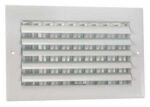 Typical air vents (registers)
Typical air vents (registers)(click to enlarge)
The screens covering the openings of a ventilation system, also called registers, usually have slits as openings as shown in the illustrations to the right. The type used in the Morgues #1 of Crematoria II & III at Auschwitz merely had very small holes, which increased the drag of the air-intake system considerably. Since these screens were made by the Auschwitz inmate workshop in early 1943, it is safe to assume that the Topf employees designing the ventilation system in November 1941 and March 1942, including its blowers and motors, did not know what these registers would look like. Rough calculations of the ventilation system’s drag indicate that these vents actually caused half of the system’s pressure loss.
If the engineers or fitters involved in installing the system wanted to reduce that drag, thus increase the air flow, the easiest way to accomplish this would have been by increasing the diameter of the holes in those screens, or by simply merging all holes of a row into a slit, rather than messing with the masonry ducting by adding additional air-intake holes.
Notes
| [1] | C. Mattogno, Le camere a gas di Auschwitz. Studio storico-tecnico sugli “indizi criminali” di Jean-Claude Pressac e sulla “convergenza di prove” di Robert Jan van Pelt. Effepi, Genoa, 2009; Engl.: The Real Case for Auschwitz: Robert van Pelt’s Evidence from the Irving Trial Critically Reviewed, Castle Hill Publishers, Uckfield 2015. |
| [2] | The plan was published by Annegret Schüle in the book Industrie und Holocaust. Topf & Söhne – Die Ofenbauer von Auschwitz. Wallstein Verlag, Göttingen, 2010, pp. 438f. |
| [3] | RGVA (Rossiiskii Gosudarstvennii Vojennii Archiv, Russian State Archive of the War, Moscow), 502-1-312, p. 69. |
| [4] | J.-C. Pressac, Auschwitz: Technique and operation of the gas chambers. The Beate Klarsfeld Foundation, New York, 1989, p. 288. |
| [5] | APMO (Archiwum Państwowego Muzeum w Oświęcimiu, Archive of the State Museum of Auschwitz), BW 30/34, p. 97. |
| [6] | Stadtarchiv Erfurt (Municipal archive of Erfurt), 5/411 A 195. |
| [7] | Höss Trial, Vol. 11, pp. 81-97. |
| [8] | Ibid., pp. 83, 84. |
| [9] | Ibid., p. 87. |
| [10] | J.-C. Pressac, Auschwitz: …, op. cit. (note 4), p. 234. |
| [11] | RGVA, 502-1-312, p. 66. |
| [12] | RGVA, 502-1-313, p. 63. |
| [13] | APMO, BW-30/34, p. 76. |
| [14] | APMO, BW-30/34, p. 68e. |
| [15] | APMO, Dokumentacja Central Construction Office, AuII BW 30/31, p. 26. Sygn. D-Z.Bau/2540. Cfr. J.-C. Pressac, Auschwitz: …, op. cit. (note 4), p. 370. |
| [16] | J.-C. Pressac, Auschwitz: …, op. cit. (note 4), p. 487, stating that they were 7 cm × 13cm, and their width:length ratio is indeed 7:13. |
| [17] | Ibid., p. 234. |
| [18] | Erläuterungsbericht zum Neubau des Leichenkellers im K.L. Sachsenhausen, 15 July 1940; Statische Berechnung für den Neubau des Leichenkellers im K.L. Sachsenhausen, 20 July 1940. BAK, NS-3/377, pp. 11-31; 69-88. |
| [19] | BAK, NS-3/377, p. 91, progressive no. 2537, Drawing K. 1 |
| [20] | J.-C. Pressac, Auschwitz: …, op. cit. (note 4), pp. 294f., 302 and 329. |
| [21] | Ibid., p. 369. |
| [22] | From: J.-C. Pressac, Le macchine dello sterminio. Auschwitz 1941-1945. Feltrinelli, Milan 1994, Document 15, outside text. |
| [23] | In the section II “Abluft”, stale air. |
| [24] | RGVA, 502-1-327, pp. 151-157. |
| [25] | APMO, BW 30/34, p. 88 and 91 (carbon copy). |
| [26] | APMO, BW 30/34, p. 84 and 61 (copy). |
| [27] | Letter of the Topf company to the Central Construction Office of February 17th 1943. Reproduced by A. Schüle, op. cit. (note 2), p. 456. The letter identifies the Leichenkeller 1 with a “Gaskeller”, gas basement. About the meaning of this term we refer to C. Mattogno, Le camere a gas di Auschwitz, op. cit. (note 1), Chapter 2.1., pp. 46-61. |
| [28] | Ibid., Chapter 2.8, “Holzgebläse”, pp. 113-118. |
| [29] | RGVA, 502-1327, pages. 25-25a. |
| [30] | J.C. Pressac, Le macchine dello sterminio, op. cit. (note 22), Document 37, outside text. |
| [31] | Ibid., p. 48. |
| [32] | Ibid., p. 101. |
| [33] | Letter of the Topf company to the Construction Office of October 31st 941. RGVA, 502-1-312, p. 103. |
| [34] | J.-C. Pressac, Le macchine dello sterminio, op. cit. (note 22), Document 9 outside text. |
| [35] | Ibid., Documents 10-11. |
| [36] | RGVA, 502-1-313, pp. 81-83. |
| [37] | RGVA, 502-1-312, pp. 75-76. |
| [38] | RGVA, 502-1-138, pp. 218-218a. Cfr. C. Mattogno, I forni crematori di Auschwitz. Studio storico-tecnico con la collaborazione del dott. ing. Franco Deana. Effepi, Genoa, 2012, vol. I, pp. 402-403; Engl.: The Cremation Furnaces of Auschwitz: A Technical and Historical Study, Castle Hill Publishers, Uckfield 2015. |
| [39] | Marco Dal Prà “Motori elettrici trifase. Guida teorica e pratica”, in: www.marcodalpra.it/downloads/Elettrotecnica/Motori_Trifasi_Guida_3.3.pdf. |
| [40] | C.IM.I. Ventilatori, in: www.cimiventilatori.it/pdf/cimiventilatori.pdf. |
| [41] | Manuale dell’ingegnere Colombo. Hoepli, Milan, 1926, p. 481. |
| [42] | Cesare Mario Arturi, Elettrotecnica II. Bologna, 2012, p. 500. |
| [43] | Manuale dell’ingegnere Colombo, op. cit. (note 41), p. 481. |
| [44] | RGVA, 502-2-26, page. 220; and 502-1-327, p. 1. |
| [45] | RGVA, 502-2-26, p. 223. |
| [46] | RGVA, 502-1-312, p. 135. |
| [47] | Siemens Handbücher, Vol. 15, 1926, p. 143. |
| [48] | Otto Lueger, Lexikon der gesamten Technik und ihrer Hilfswissenschaften, Stuttgart, Leipzig, Vol. 5, 1907, p. 799. |
| [49] | RGVA, 502-1-312, pp. 138-140. |
| [50] | R.J. van Pelt, The Case for Auschwitz: Evidence from the Irving Trial. Indiana University Press, 2002, p. 365. |
| [51] | Currently at www.phdn.org/archives/holocaust-history.org/auschwitz/chemistry/not-the-science/ |
| [52] | Without calculation of the volume occupied by the central beam and by the seven support pillars. |
| [53] | Institute for Historical Review, Newport Beach, 1994. |
| [54] | Edizioni di Ar, Padua, 1994. |
| [55] | Auschwitz: The End of a Legend, pp. 110-113; Auschwitz. Fine di una leggenda, pp. 81-84. |
| [56] | Ibid., pp. 60f.; pp. 55f.. |
| [57] | Report of Richard J. Green, PHD., in: www.phdn.org/archives/holocaust-history.org/irving-david/rudolf/affweb.pdf, p. 7. |
| [58] | This is a nonsensical lie. Mattogno based himself on the Topf invoices no. 171 of February 22nd and no. 729 of May 27th 1943, which he compared to the cost estimate of November 4th 1941 to prove exactly that the number of air exchanges foreseen for a normal morgue remained unchanged also after its alleged transformation into a homicidal “gas chamber”. |
| [59] | W. Heepke, Die Leichenverbrennungs-Anstalten (die Krematorien). Verlag von Carl Marhold, Halle a. S., 1905, p. 104. Facsimile of the p. in: Auschwitz. Fine di una leggenda, p. 85; Auschwitz: The End of a Legend, p. 114. |
| [60] | RGVA, 502-1-312, p. 136. |
| [61] | J.-C. Pressac, Auschwitz: …, op. cit. (note 4), p. 377. |
| [62] | En lisant de près les écrivains chantres de la Shoah. Paris, 1991. |
| [63] | Ibid., p. 39. |
| [64] | Gallimard, 1981. |
| [65] | J.-C. Pressac, Auschwitz: …, op. cit. (note 4), p. 474. |
| [66] | For the numerical data please consult the study of C. Mattogno, La deportazione degli Ebrei ungheresi del maggio-luglio 1944: Un bilancio provvisorio, Effepi, Genoa, 2007. |
| [67] | J.-C. Pressac, Auschwitz: …, op. cit. (note 4), p. 286. |
| [68] | Ibid., pp. 323, 325 and 327. |
| [69] | Höss Trial, Vol. 2, pp. 99f. |
| [70] | Höss Trial, Vol. 25, p. 498. |
| [71] | R.J. van Pelt, The Case for Auschwitz, op. cit. (note 50), pp. 470-472. |
| [72] | J.-C. Pressac, Auschwitz: …, op. cit. (note 4), p. 475. |
| [73] | Terza Università di Roma. Facoltà di Roma. Antropometria. in: www.iuav.it/Ateneo1/docenti/architettu/docenti-st/Domenico-B/documentaz/antropometria.pdf. |
| [74] | F. Piper, “Gas Chambers and Crematoria”, in: Yisrael Gutman and Michael Berenbaum Editors. Anatomy of the Auschwitz Death Camp. Indiana University Press, Bloomington and Indianapolis, 1994, p. 170. |
| [75] | D. Czech, Kalendarium der Ereignisse im Konzentrationslager Auschwitz-Birkenau 1939-1945. Rowohlt Verlag, Reinbek bei Hamburg, 1989. |
| [76] | F. Piper, Die Zahl der Opfer von Auschwitz. Verlag Staatliches Museum (sic) in Oświęcim, 1993, p. 186. |
| [77] | J.-C. Pressac, Auschwitz: …, op. cit. (note 4), p. 487. |
| [78] | R.J. van Pelt, The Case for Auschwitz, op. cit. (note 50), p. 208. |
| [79] | J.-C. Pressac, Auschwitz: …, op. cit. (note 4), p. 16. |
| [80] | J.-C. Pressac, Le macchine dello sterminio, op. cit. (note 22), p. 84. |
| [81] | R. J. van Pelt, The Case for Auschwitz, op. cit. (note 50), p. 366. |
| [82] | NI-036; NI-034. |
| [83] | C. Mattogno, Le camere a gas di Auschwitz, op. cit. (note 1), pp. 453-454. |
| [84] | R. Irmscher, “Nochmals: “Die Einsatzfähigkeit der Blausäure bei tiefen Temperaturen”“, in: Zeitschrift für hygienische Zoologie und Schädlingsbekämpfung, no. 34, 1942, p. 36. It takes huge amounts of Zyklon B in order to reach high HCN concentrations after only a few minutes; see Germar Rudolf, The Chemistry of Auschwitz, Castle Hill Publishers, Uckfield 2017, pp. 247-267. |
| [85] | Volume of the pillars and of the beam. |
| [86] | Volume of the corpses of the victims. |
| [87] | R. J. van Pelt, The Case for Auschwitz, op. cit. (note 50), p. 502. |
| [88] | Ibid., p. 366 |
| [89] | RGVA, 502-1-32, p. 300. |
| [90] | RGVA, 502-1-8, p. 25. |
Bibliographic information about this document: Inconvenient History, Vol. 9, No. 3 (2017)
Other contributors to this document: n/a
Editor’s comments: n/a

